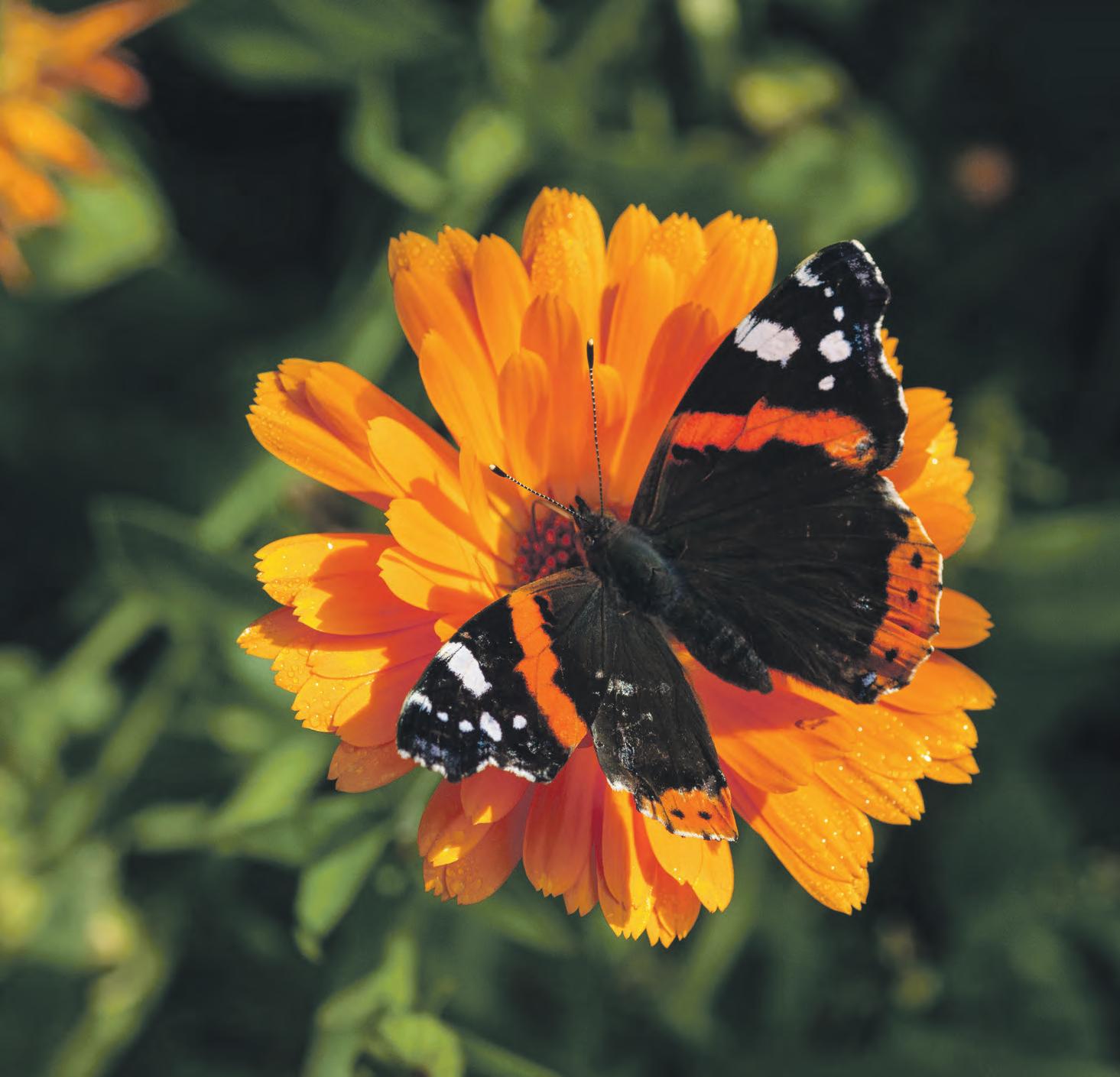


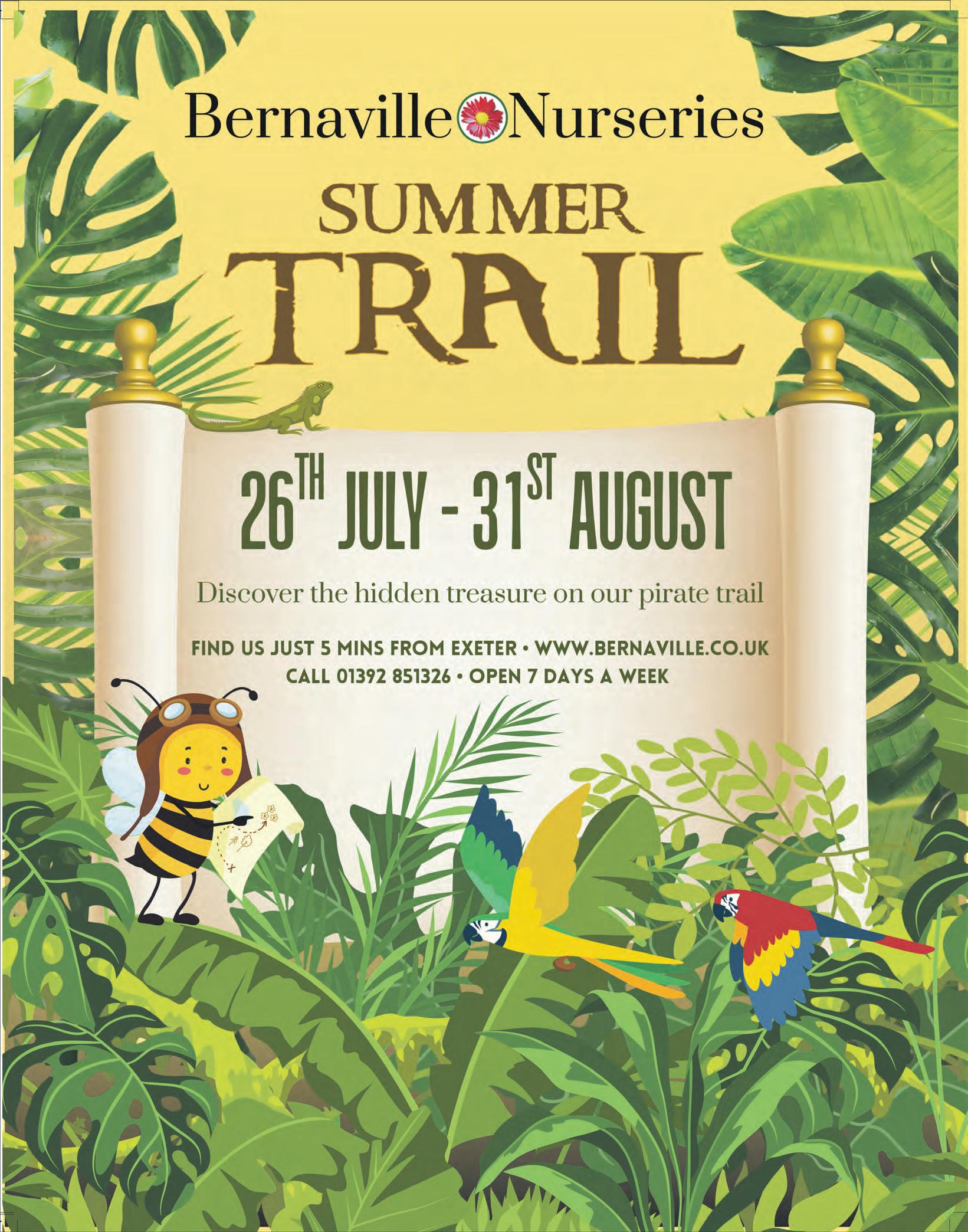





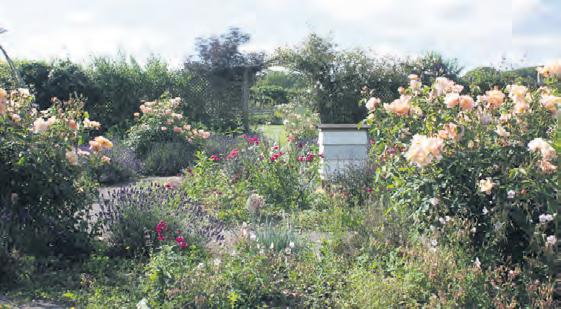
Make for a garden full of butterflies, birds and bees in a family-run honey farm in the East Devon countryside when Blackbury Honey Farm at Southleigh near Colyton opens for Hospiscare, Devon’s hospice charity, on Saturday 16th and Sunday 17th August from 10am until 4pm each day. The garden at the honey farm has beds and borders exuberantly planted with annuals, perennials, flowering shrubs, bulbs and roses, a herb garden, orchard and wildflower meadow. Paths are cut through and there’s a viewing mound to see the whole site.
Fruit and vegetables are grown, salads and vegetables in polytunnels for the tearoom. There are plenty of benches and corners to sit and enjoy the peaceful atmosphere, and there’s a plant sale. There’s parking including disabled parking on site, a mix of grass and hard paths with easy access to the tearoom. Toilets on site. Dogs are not allowed.
Blackbury Honey Farm, Southleigh, Colyton, Devon EX24 6JF

Cockington Country Park in Torquay, the popular woodland and open parkland in a 450 acre country park has again been chosen as one of the winners of the coveted Green Flag Awards for 2025. It has been able to fly the flag every year since the first awards were made in 1997.
The country park which includes three ornamental lakes, an historic Manor House with craft centre and studios, a chocolate box village, delightful, thatched cottages and a quaint 11th Century church, has reached the high standards required to receive a coveted award.
Environmental charity Keep Britain Tidy has revealed the winners, with successful submissions from across the country for a range of sites including world-famous city parks and small, local green spaces.
The Green Flag Award is the benchmark international quality classification for parks and green spaces, providing the high standards against which sites are measured, and which land managers, local authorities, and volunteers pledge to achieve when applying for the award.
The scheme was launched 29 years ago, with the first awards given a year later.
Some of the UK’s most celebrated horticulturalists and florists will be at the popular RHS Garden Rosemoor as it stages its most ambitious flower show programme to date.
From Friday, 15th August to Sunday, 17th August, visitors to the RHS Rosemoor Flower Show will be treated to a packed schedule of expert talks, demonstrations and floral artistry, featuring award-winning gardening and floristry names.
The new line-up begins on Friday with Jekka McVicar who will open the Talks Tent with insights from her new book 100 Herbs to Grow
On Saturday, houseplant expert Joe Bagley, known as The Houseplant Doctor™, will take the stage with a lively session sharing practical tips from his latest book How To Make Your Houseplants Love You. Joe has made appearances on BBC Gardeners’ World and presents for BBC Gardeners’ World Live.
Broadcaster and writer Carol Klein will close the weekend on Sunday, introducing her memoir Hortobiography, which reflects on the gardens


that have shaped her life and career – from childhood to television fame.
Meanwhile, in the garden room, top floral designers will showcase sustainable and seasonal creations. Angela Turner, a National NAFAS demonstrator with over three decades of experience and multiple RHS Chelsea Gold medals, will appear on Friday.
A limited number of Early Bird Tickets are available, granting access to the event one hour before general opening on Friday or Saturday. Early entry to the two days includes easier parking, first pick of plant sales, and a breakfast offering at the Shepherds Rest café.
RHS Garden Rosemoor, Torrington EX38 8PH
Taking place on the August Bank Holiday Monday 25th August this traditional country show in Lustleigh features a horticultural show, dog show, and displays in the main ring. It’s a charming village event with a history dating back to 1887. Tickets are £10 and £4 for under 14’s. The show is normally a busy, highprofile event attracting up to 4,000 visitors.
Exmoor National Park Authority has unveiled a new five-year plan setting out a vision for the future of one of the UK’s most treasured landscapes.

Developed through consultation with communities, partners, and stakeholders, the new plan has been formally adopted at a meeting of the Exmoor National Park Authority.
The plan sets out a vision for Exmoor as a thriving, nature-rich landscape that leads the way in climate action, supports vibrant communities, and welcomes all who seek inspiration and connection with nature.
Exmoor’s special qualities have been defined as:
Large areas of open moorland providing a sense of remoteness, wildness and tranquillity rare in southern Britain.
A distinct diverse landscape of softly rounded hills and ridges, with heather and grass moors, spectacular coast, deeply incised wooded valleys, high sea cliffs, fast flowing streams, traditional upland farms and characteristic beech hedge banks.
A timeless landscape mostly free from intrusive development.
An exceptional rights of way network, with paths that are often rugged and narrow in character, along with extensive areas of open country and permitted access, providing superb opportunities for walking, riding, and cycling.
The change always comes about mid-August and it always catches me by surprise. I mean the day when I know that summer is fraying at the edges. HAL BORLAND
Someone is sitting in the shade today because someone planted a tree a long time ago.
WARREN BUFFETT





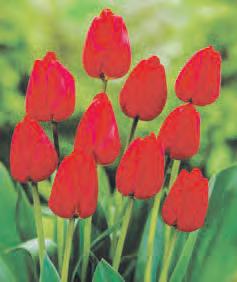




Incorporating native wildflowers into our gardens has significant benefits.
Native plants have evolved in tandem with other species of insects, pollinators and birds, forming intricate relationships; vital to ecosystem health and resilience. Cow parsley is a nectar source for the native Orange-tip butterfly, bees and hoverflies.
The common dog violet is a food source and host plant for the rare silver-washed (above right)), high brown and dark green fritillary.
Honeysuckle has a huge value to wildlife supporting the rare white admiral butterfly, bumblebees and moths. Honeysuckle berries provide a food source for thrushes, warblers and bullfinches and dormice curiously incorporate honeysuckle bark into their nest building material and eat the nectar rich flowers.
Native plants are climate adapted, adjusted to our seasons
On Monday 25 August, Tapeley Park Gardens in North Devon hosts a one day Vintage Fair & Market, set against the backdrop of its historic Grade II* listed house and stunning Italian terraces. Entry is £5 for adults (under 16s free), admission includes full access to the landscaped gardens. From 10am to 4pm, there will be 100 artisan stalls showcasing a delightful array of antiques, salvage, retro homewares, original artwork, vintage clothing, jewellery, lighting, garden pieces—and more. Dogs allowed dogs on leads. The event is conveniently on-site with parking (though lift sharing is recommended due to limited space).
Tapley Park Gardens Bideford EX39 4NT

and temperatures. They require less maintenance and resources with inbuilt resistance to pest and diseases and more resilience than non-natives. But consideration should still be given to the natural habitat of the species. A native plant species from chalky grasslands is unlikely to settle successfully in a woodland-edge, heavy clay soil!
Incorporating a tapestry of native plant species can in short help to protect regional biodiversity and build more robust landscapes.
For wildflower plug plants head to Naturescape www.naturescape.co.uk or The Blooming Wild Plant Nursery www.plantwild.co.uk
If you live in the south west and would like advice and help to transform your garden into a bespoke, beautiful, sustainable and biodiverse outdoor space, contact rosie@rosemarytree.co.uk
Sources: woodlandtrust.org.uk, wildlifetrusts.org, unsplash.com. 2025.

Marwood Hill Gardens, the award winning gardens in Barnstaple opens for the NGS charity on Friday, 22nd August. Home to four National Plant Heritage collections and numerous champion trees, these private valley gardens span over 20-acres. Showcasing three stunning lakes, sculptures, rare trees and shrubs, and colourful surprises throughout each season, Marwood Hill Gardens is a delight.
Winners of a Gold Medal, as well as being awarded a ‘Best in Show’ at Hampton Court in 2023, the Devon garden is best known for its incredible astilbe collection, as well as its national collections of iris ensata, tulbaghia and its very own Marwood collection.
Marwood Hill Garden, Barnstaple EX31 4EB

Have you visited the stunning gardens at North Devon Hospice? If not, this September could be your chance to do so! On Sunday 7th September from 10am to 4pm, the hospice will be hosting the annual open gardens event.
Explore the tranquil hospice gardens and discover the array of flora and fauna throughout the manicured grounds. Those feeling inspired to make their own gardens even more beautiful can visit the retail stall.
Guests visiting with little ones can drop by the Kids Craft areas to enjoy a host of nature- activities before embarking on their own mini adventure exploring the hospice’s Magical Children’s Trail, with a prize at the end. There is also a teddy bears’ picnic this year - with delicious kids picnic boxes, available throughout the day - so everyone can relax and take in the surroundings, with their favourite cuddly toy!
There will be a BBQ on the Terrace Café Balcony offering some delicious bites, and of course, no Open Garden would be complete without a proper Devonian Cream Tea! Dine al fresco while overlooking the beautiful gardens on a late summer’s day .
Entry to the hospice’s Open Gardens is free but donations to support the charity’s vital work caring for local people facing a life-limiting illness and beyond, will be welcome.
To find out more, visit northdevonhospice.org.uk or call 01271 344248.
Kia-Ora Farm & Gardens, in Cullumpton will be open to visitors on selected days in August and September — including August 3rd, 24th, and September 7th and 21st. This hidden garden gem offers a delightful mix of nature and relaxation, ideal for families, couples, or solo explorers. It comprises of nearly 10 acres of planted gardens and lakes, set in beautiful countryside.
The extensively planted gardens create an idyllic, peaceful setting with vast lawns, large lakes, ponds, bog gardens and various water features including its own waterwheel and mill, a paradise for swans, ducks, geese and endless other wildlife.
Kia-Ora Farm & Gardens Knowle Ln, Cullompton EX15 1PZ
Devon Subtropical Garden, a privately owned oasis in Barnstaple, reopens this year for three special National Garden Scheme dates. Nestled at 32 Allenstyle Drive, EX31 3DZ, this petite yet lush space has matured over nearly two decades, featuring bananas, gingers, cannas, colocasias, scented passionflowers, a wildlife pond, and a striking new cedar greenhouse and refurbished pond areas added two years ago.
Open Days (with National Garden Scheme):
• Sunday 17 August, 11:00–16:00 (group opening)
• Sunday 24 August, 12:00–17:00 (pre booking available)
• Sunday 7 September, 12:00–17:00 (pre booking available)

Admission is £5 for adults, children free. Besides these Sunday openings, the garden welcomes group visits throughout August and early September—ideal for gardening clubs or enthusiasts looking for a more personal tour. The owners also offer illustrated talks on passionflowers and tropical gardening in the UK. Group visits by arrangement are available from 15 August to 12 September, with refreshments like tea, coffee, and cake included.
The SEPTEMBER issue of Country Gardener will be available from Saturday 30th August
Find your nearest stockist www.countrygardener.co.uk/magazine/stockists
The Okehampton Show, the vibrant one day agricultural extravaganza on Stoney Park’s northern edge of Dartmoor is being held on Thursday, 14th August (gates open at 9am). It features nearly 400 livestock classes—from cattle and sheep to goats and pigs—with a grand afternoon parade of champions. A bustling entertainment ring delights with falconry, gun dog demos, ferret and terrier racing, Morris dancers and stunt bikes. Families enjoy a dedicated zone hosting climbing walls, giant tortoises, vintage tractor displays, craft and food marquees offering local produce, and handicraft competitions.
Stoney Park Showground, Holsworthy Road, Okehampton EX20 1SW
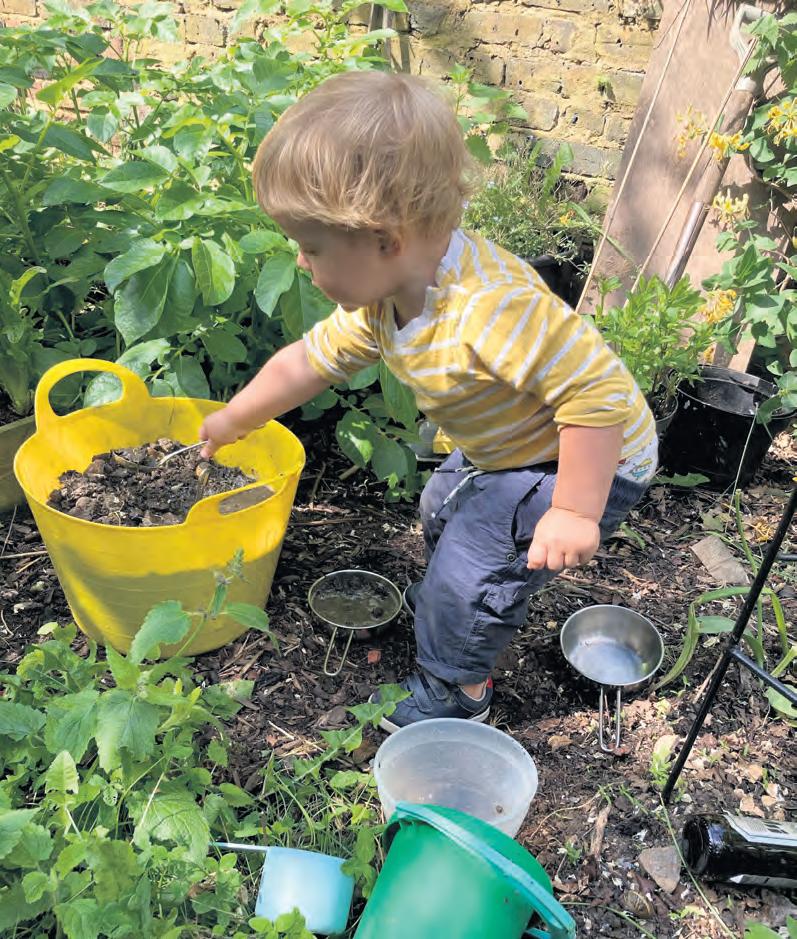
Gardening with young children isn’t just about growing tomatoes—though tomatoes do play a key role—it’s about planting seeds of curiosity, patience, and unexpected hilarity.
Gardening with children can be a bonding experience and fun. It offers lots and lots opportunities for learning and growth, both for the child and the adult. However, like any activity involving young children, it also comes with its share of challenges. Despite the mess, the drama, and the unexpected worm-eating incident (it only happened once, I swear), gardening with children is one of those rare parenting activities that’s both wholesome and genuinely fun.
You’ll teach them patience, perseverance, and how to bounce back when something doesn’t grow the way they hoped. You’ll watch them discover the magic of nature and see their faces light up when they harvest their first carrot—even if it’s half the size of a baby carrot and oddly shaped like a toe.
Gardening teaches them that good things take time. That dirt washes off. That bugs have a purpose. That you can start with almost nothing—just a seed and some soil—and end up with something amazing.
And if all else fails, you can always plant more cherry tomatoes. Kids will eat those straight off the vine.
Kids are natural scientists. Hand them a packet of seeds and a watering can, and suddenly you’ve got a botanist-in-training. Gardening teaches biology, weather, seasons, responsibility, and maths The difference is, they’re learning through doing, not staring at a whiteboard or screen. Gardening provides a hands-on learning environment that can properly help subjects such as science, math, and even literacy. Children are keen observers of processes like plant life cycles, pollination, and weather patterns, helping them grasp complex scientific concepts in an engaging way.
Taking children away from screens can feel like major negotiations. Gardening in comparison is a form of moderate physical exercise that can improve. Tasks such as digging, planting, watering, and weeding help develop hand-eye coordination and muscle strength. Unlike passive screen time, gardening gets children moving, bending, and lifting, which supports their physical health and helps combat sedentary lifestyles.
Spending time in nature has been shown to reduce stress, anxiety, and symptoms of depression. Gardening promotes mindfulness as children focus on caring for their plants and observing changes in the environment. Watching a seed grow into a blooming flower or a vegetable they can eat provides a sense of accomplishment and boosts self-esteem. For some children, especially those with special needs, gardening can offer a calming and therapeutic outlet.
Gardening with children can be very rewarding as Devon mother of two Tracey Jones has found. It’s something that offers lots of educational, and emotional benefits. It encourages curiosity, nurtures responsibility, promotes healthy habits, and strengthens bonds between children and caregivers. At the same time, it needs a lot of patience and cleaning
Not all children will suddenly develop a passionate love for kale just because they planted it, but you’d be surprised how often they’ll munch a raw carrot or nibble a cherry tomato if they grew it themselves. Growing fruits, vegetables, and herbs can certainly encourage children to try and enjoy nutritious foods. They are more likely to taste and appreciate what they have grown themselves. This can lead to healthier eating patterns, reduced reliance on processed foods, and an increased interest in cooking and nutrition. Gardening gives children a tangible connection to where their food comes from.
The bad news…
Of course, gardening with children is not all daisies and delighted giggles. Sometimes it’s sweat, tears, and a suspiciously dug-up potato patch.
Gardening involves tools, soil, and sometimes potentially harmful plants or insects. Without proper supervision, children might injure themselves with sharp tools, trip over hoses, or encounter thorns, stinging insects, or allergenic plants. Ensuring a child-safe garden setup—with age-appropriate tools and clearly defined boundaries—is crucial to minimizing risks.
Gardening is inherently messy, which can be off-putting for some adults. Dirt, mud, and water can create clean-up challenges, especially if the garden is inside or close to the home. Managing expectations and preparing appropriately—with smocks, gloves, and designated clean-up areas—can help with this .The line between ‘digging to plant carrots’ and ‘digging a moat around the sandbox’ ‘is thin. One minute you’re demonstrating how to use a trowel, the next they’ve gone full archaeologist in your flowerbed.
Some plants will receive zero water. Others will be so loved, they drown. Then there’s the possibility your child forgets to aim the watering can at all and soaks you, the dog, or their own shoes instead. Children may not understand the intricacies of plant care or pest control. They might overwater plants, step on seedlings, or inadvertently spread pests. Teaching children slowly and supervising closely can prevent this, but it requires patience and a willingness to accept some trial and error. Using natural, non-toxic pest control methods is especially important in a child-friendly garden.
Time and commitment
Gardening really does need consistent effort over weeks or months, which can be challenging to maintain, particularly during busy school schedules or family holidays. If interest wanes or time becomes limited, plants may wither, and children may feel discouraged. But it is above all and for most of the time very rewarding.



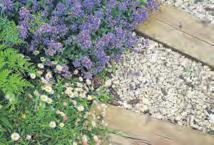
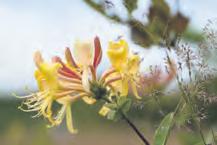
Elevate Your Home with Sustainable Garden Design
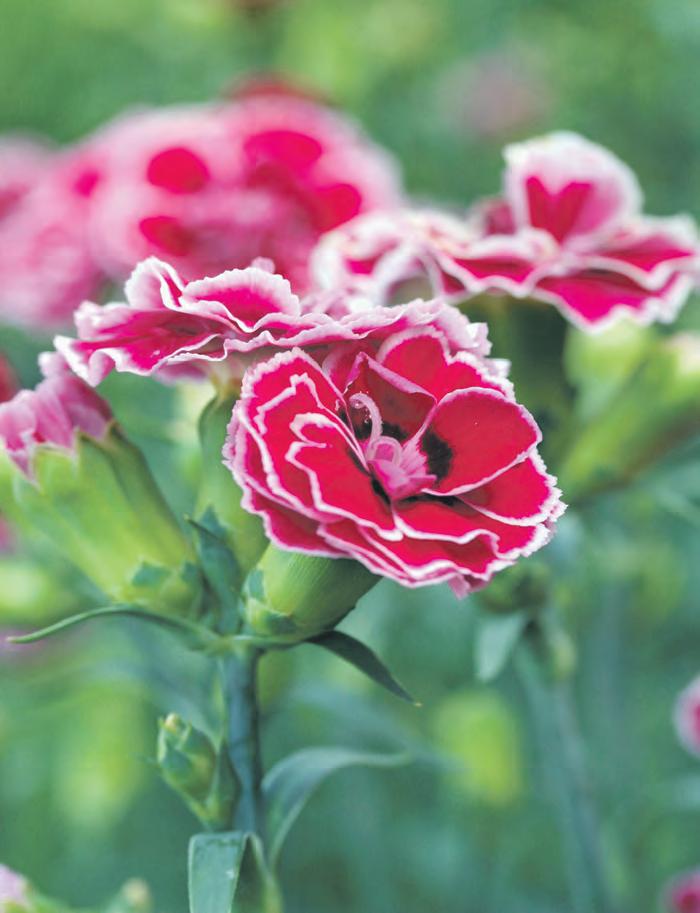


Create a space that restores and inspires. Therapeutic, wildlifeenhancing gardens designed with harmony, structure, and seasonal beauty. Grounded in nature, rooted in well-being. www.rosemarytree.co.uk rosie@rosemarytree.co.uk If you would like to advertise your


FURSDON HOUSE AND GARDEN
HISTORIC MANOR HOUSE Beautiful informal gardens Stunning setting Delicious home-made teas GARDENS & TEA ROOM OPEN 2pm-5pm, Weds, Thurs & B Hols until the end of September For house opening, please see website Dogs on leads welcome in the garden Fursdon, Cadbury, Exeter, EX5 5JS Tel: 01392 860860 www.fursdon.co.uk
Fine Turf (Devon) Ltd, a a locally seeded turf, suitable treated and fertilised several
We also supply topsoil, composts your gardening needs, we can for planting flowerbeds and vegetable certified and stored dry all year


652538 Lower Waye Farm, Ashburton

TEL: 01364 652538
EMAIL: fineturfdevon@gmail.com
WEBSITE: turfdevon.co.uk
Residents at Kenwith Castle care home visited RHS Garden Rosemoor as part of the home’s ‘Make a Wish’ initiative.
Val, who lives at the care home in Abbotsham, told the team about how she would like to go back to the gardens where she had volunteered for many years after retiring. ‘Make a Wish’ is just one of the many initiatives at Kenwith Castle which enable residents to talk about their hobbies and interests that they used to enjoy or would like to try but would not be able to do without the team’s help. In turn, the care home team safely makes the wish come true. Val was thrilled to go back to RHS Garden Rosemoor to explore the rose garden, hot garden, cool garden and the fruit and vegetable plots. She also told the care home team about her experiences there, including that each gardener had a robin that would often visit them while they worked in the garden.
Following her visit, Val said: “It was just lovely. It brought back such happy memories of working on a patch for so many weeks and the robin always following me. In fact, a robin came and sat on the sign whilst I waited for the bus back to the care home. I think it was coming to say goodbye to me. It was just so wonderful.”
Kenwith Castle care home combines the elegance and character of its 18th Century original architectural style with 21st Century care home comfort, supporting residential, respite and dementia care. The home is operated by not-for-profit charity, Care South, a leading provider of high quality residential and home care services across the south of England. The not-for-profit organisation, which is a registered charity, has care homes
in Dorset, north Devon and Somerset, and care at home offices covering east and west Dorset, and Somerset. Jo Passmore, Home Manager at Kenwith Castle care home, said: “It was lovely to see Val’s face light up as we told her that she would be going to RHS Garden Rosemoor. She has so many cherished, happy memories of tending to the gardens over the years with the other volunteers and so it was lovely to enable her to go back and visit again. At Care South, we love to enable our residents to enjoy their hobbies as well as trying something new. It was incredibly special to see Val return to a place that holds so many happy memories for her.”

Kenwith Castle care home has a large garden and benefits from wider landscaped grounds featuring a picturesque lake with stunning countryside views offering space for a moment of reflection, as well as a beautiful backdrop for barbecues and garden parties.
The grounds are also home to assisted-living bungalows, Kenwith Castle Gardens and Kenwith Meadows, as well as The Pavilion, which offers a meeting place for residents to get together for a range of events.
For more information about the care services available at Kenwith Castle, go to care-south.co.uk or call 01237 879594 to book a tour.
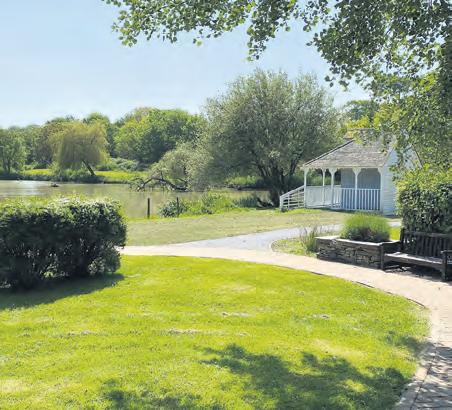


August is exactly the right time to cut back the vigorous growth of shrubs and climbers. It is important to keep them in shape but even more to encourage them to focus all their strength on producing next year’s buds
From April through to the end of June most woody plants grow at a phenomenal rate but by the early weeks of August nature has put the brakes on and that mad rush of leafy growth is pretty much over.
So, it’s time to take many plants in hand.
Thinning and reducing the amount of foliage controls size and allows more air and sunshine through the plants, speeding the ripening of flowering and fruiting woods and diverting the plant’s energy into the important task of producing buds for next year. Summer is also the perfect time to prune vines which have a tendency to bleed or produce sap.
Remember anything which blooms in spring should be left alone otherwise you will be removing next spring’s flowering shoots.
The plants to tackle now are the summer flowering and fruiting shrubs and climbers.
Wisteria is best pruned twice a year, in August and again in January or February. They can be left to ramble unchecked where space allows,but will usually flower more freely and regularly if pruned twice a year. The removal of growth in summer allows better air circulation and more sunlight to reach the base of the young growths, encouraging better ripening of the wood and improving the chances of flower bud formation.
Restricting the amount of growth and encouraging short flowering spurs will result in more flowers.
After flowering, in July or August, cut back the whippy green shoots of the current year’s growth to five or six leaves.

Climbing roses are the perfect plants to add height to a garden. Nearly all climbers offer more than one flush of flowers, and the time to prune is late summer through winter, while the rose is dormant. If you don’t prune your climbing rose it’s not the end of the world. However, you’re likely to end up with a jumbled mass of weak, twiggy stems, which can dominate at the expense of flower production. What’s more, crossing stems can cause dieback and lead to disease, making your climbing rose more susceptible to fungal infections.
When pruning climbing roses, cut just above a bud that points in the direction you want a new stem to grow. Avoid cutting above a bud that will direct growth to the garden path, for example.
Lavender can get woody and leggy if it is left untouched. This potential issue can be combated by pruning lavender every year and August is an ideal time to trim hardy
lavender in many climates. The hardiest type is English lavender and they respond best to this type of summer pruning.
If you are growing lavender, the time to prune is after the aromatic herbs have finished flowering, which can be in late August or early September. Cutting back each year keeps the growth compact and dense, ensuring your lavender looks at its best for years to come.
Trim lavender back to a neat shape, taking care to cut back to green growth and new shoots. Avoid making the mistake of cutting in the woody part of the plant, as the plant is not guaranteed to reshoot from such old, bare wood.

Pyracantha is a fantastic shrub that is loved for the bright berries it produces, which come in fiery shades of red, orange and yellow. It is a great landscaping shrub, but is also commonly grown as an evergreen climber - such as to hide a garden wall. A climbing pyracantha makes a great feature, but will benefit from additional pruning in August.
Pyracantha, or firethorn, can get large and unruly if left to their own devices and it is useful to keep this vigorous plant in check. They want to be pruned in mid-spring and then climbing types given a second prune in midsummer, which not only opens the plant up to put the dazzling berries on full display but encourages next year’s flowering and fruiting.
Laburnums are glorious trees, producing dazzling yellow flower clusters in late spring and early summer. They are popular as specimen free-standing trees and also often seen trained to grow as climbing plants over arches or pergolas, where the hanging flowers can make a fantastic sight.
Laburnum does not necessarily need lots of regular pruning, but when it does, getting the timing right is important. Late summer is the best time, after they have finished blooming - though they can be pruned through fall also. If laburnums are pruned in spring or early summer they are renowned for bleeding sap, which can leave the tree susceptible to pests and diseases.
August is a good month to prune many deciduous hedges, including beech, hawthorn, hazel, and hornbeam. Trimming for shape in summer will keep the hedge looking neat for the coming months and through fall and winter when all the leaves drop. Fastgrowing hedges want to be trimmed in spring and in summer annually to keep them tidy.
Larger deciduous hedges will benefit from a hedge trimmer and the resulting cuttings can be added to any home compost heap.
Butterfly numbers are the lowest on record and over the next few weeks the annual count in gardens all over the southwest is being seen as critical

• Butterflies like warmth so choose sunny, sheltered spots when planting nectar plants.
• Choose different plants to attract a wider variety of species. Place the same types of plant together in blocks.
• Try to provide flowers right through the butterfly season. Spring flowers are vital for butterflies coming out of hibernation and autumn flowers help butterflies build up their reserves for winter.
• Prolong flowering by deadheading flowers, mulching with organic compost, and watering well to keep the plants healthy.
• Don’t use insecticides and pesticides - they kill butterflies and many pollinating insects as well as ladybirds, ground beetles and spiders.
• Don’t buy peat compost. Peat bogs are home to many special animals and plants, including the Large Heath butterfly, which is declining across Europe.
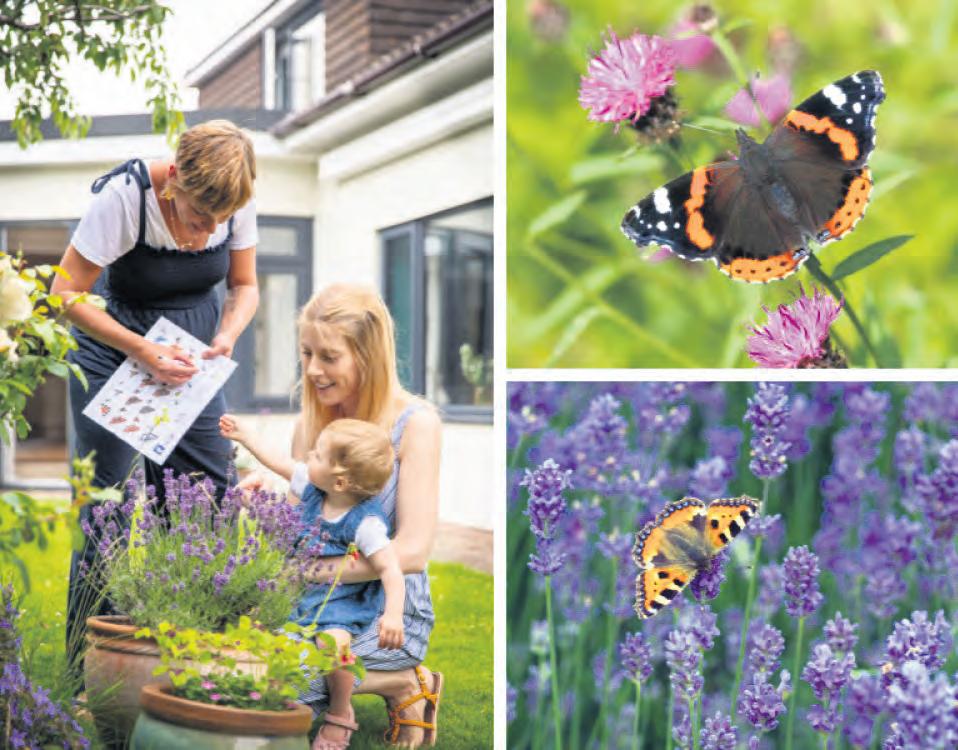
Following the results of the Big Butterfly Count 2024, the Butterfly Conservation have declared a butterfly emergency and have asked for help more than ever before.
By taking part in Butterfly Conservation’s Big Butterfly Count - a UK wide survey, over the next few weeks, gardeners can help assess the health of the environment simply by counting butterflies.
Butterfly numbers are the lowest on record in the UK after weather conditions dampened their chances of mating.
Butterfly Conservation, which runs the count, sounded the alarm after last summer’s count revealed the worst numbers since it began 14 years ago.
Many people have noticed the lack of fluttering insects in their gardens. Climate breakdown means the UK is more likely to face extremes in weather, and the natural rhythms of the seasons that insects such as butterflies are used to can no longer be relied on.
Gardens can act as important stepping stones between nature reserves and other natural habitats by offering abundant supplies of nectar and food plants.
Butterflies will visit any garden, however small if they can feed on suitable nectar plants and a well thought out garden can attract many species of butterfly. If you manage your patch to create breeding habitat you may see even more.
Nectar provides butterflies and moths with energy to fly and find a mate. In spring, it helps butterflies refuel after winter hibernation or a gruelling journey to Britain from southern Europe or Africa.
In autumn nectar helps butterflies and moths to build up their energy reserves so they have the best chance of surviving hibernation or the journey back to warmer climes. Another way to help butterflies is to allow them to breed in your garden - only with the right foodplants can they lay eggs of the next generation, and so the more we grow for them, the more butterflies there will be.
• Buddleia (The butterfly bush). Very easy to grow in almost any soil. Different varieties will flower in pink, red, purple, and white. Usually in bloom through July and August. These shrubs need pruning well in spring as they can grow five to eight feet from the ground in a single season.
• Verbena bonariensis Stems up to a metre tall support heads of lilac-purple flowers from August to October. Easy to grow from seed, plant March to April in well-drained soil. These can provide useful height at the back of a border. Only half hardy so can be a short-lived perennial.
• Lavender. Flowers are a purplish-blue in colour and grow on spikes through the summer. Plants can be used for edging beds or grown to form an attractive, low-growing hedge. It thrives in a sunny, sheltered position in well-drained soil. Lavender should be planted in April or May and pruned back to encourage bushy growth.
• Perennial Wallflower (Bowles Mauve). Produces a profusion of sweet-scented purple flowers from April all through the summer. Wallflowers make great bedding plants and will grow well in full sun or light shade. Plant in well-drained soil.

The Big Butterfly Count 2025 will take place from mid July to 10th August all across the UK. This citizen science project, organized by Butterfly Conservation, encourages people to count butterflies and day-flying moths in their local areas to help monitor the health of the environment. The Big Butterfly Count is a nationwide survey which is free and open to everyone. The count is an important indicator of environmental health.
HERE’S HOW TO TAKE PART:
Choose a location: Pick a spot to observe, like your garden, a park, or a natural area. Count for 15 minutes: Watch for butterflies and day-flying moths during a sunny 15-minute period.
Record your sightings: Submit your findings on the Big Butterfly Count website or through their free app. https://butterfly-conservation.org/events/the-bigbutterfly-count-2025
Counting butterflies can be described as taking the pulse of nature and the Butterfly Conservation Charity depends on gardeners, to help assess how much help nature needs. The data from this and other counts will also help identify important trends in species that will assist in planning how to protect butterflies from extinction, as well as understanding the effect of climate change on wildlife.
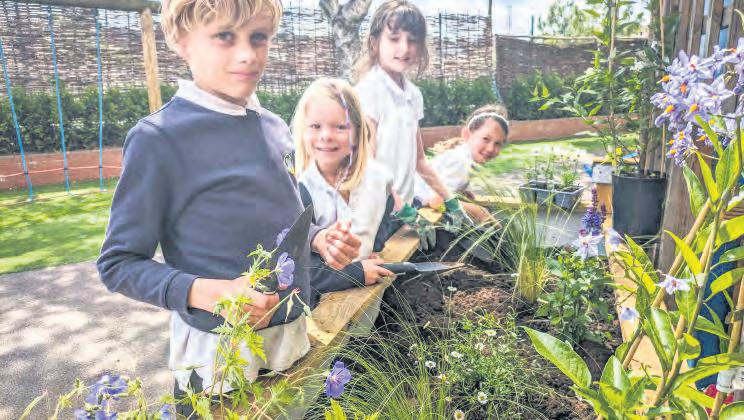
More than 2,000 children at 47 schools planted wildflower meadows, green walls and floral raised beds in their school grounds. The 18-month Bristol Wild Spaces project was co-ordinated by Butterfly Conservation.
Project Officer Angus Walker said: “This has been such a joyful project to work on. Lots of these children live in really built-up areas without gardens, so it’s just been great to see them enjoying getting outside and connecting with nature while doing something really positive for urban butterflies and moths.”
Among the highlights was St Nicholas of Tolentine Primary in the heart of the city, where pupils helped to create a mini wildflower meadow on a small patch of grass in front of the school. Parents volunteered to strip the turf, then pupils sowed native wildflower seeds in September which are now blooming. It was one of ten mini meadows created as part of the project.
At Ashley Down Primary, a school with limited outdoor space, pupils created a green wall with caterpillar food plants such as Bird’s-foot Trefoil and Ivy, and they have since seen Common Blues and Holly Blues visiting.

Summers are now drier with long periods without rain. The drier the weather the more water is needed so the pressure is now set to be permanently on gardeners to find ways to be water efficient. A new book provides most of the answers.
Rainwater is very special. It is chlorine free and does not contain calcium and magnesium which are the minerals mainly responsible for the hardness of water.
As a result it is naturally soft and slightly acidic which is the right pH for many plants. The cherry on the cake is that it’s a completely free natural resource.
That is one of the messages of Angela Youngman whose new book ‘The Water Efficient Gardener’ is set to become one of the definitive insights into the way we use and should use water in our gardens from showcasing biodiverse gardens to inventive methods for collecting rainwater to how to protect your garden against the elements.
We look at just two aspects on using water in the garden.
Rainwater is crucial for any gardener who is seeking to be water efficient so it is essential to capture as much of the free resource as possible. This has the advantage of reducing the amount of stormwater that enters the drainage system and thus reducing the risk of floods.
The harvesting of rainwater has many advantage. It provides a reliable source of rainwater for watering plants or topping up plants which saves money by reducing water bills. In the UK rainwater harvesting is a legal activity provided it is done correctly and uses three main methods water butts and barrels, rain chains, rainwater harvesting system.
Every household should have at least one water butt so ask yourself whether you have enough of them. The odds are you haven’t and could use more. They come in all shapes and sizes. The important thing is that two 55 gallon butts, one placed at either end of a house with a roof area of 10 square metres will collect most of the water which falls on the building during a winter. All water butts should be raised off the ground using bricks
There is always scope for siting several water butts around a property from sheds, greenhouses and garages. Check with your local authority as many of them are keen to encourage water collection and have great deals on purchasing water butts.

Every household should have at least one water butt
Water conservation methods can be decorative as well as functional. the concept of rain chains originated in Japan. Rain chains are designed to create a feature of the water fallings from the roof of a house. The mechanism is simple. A heavy duty chain hangs from the house roof extending down to the ground where it curls into a drainage hole which leads to an underground tank.
Rain chains are becoming increasingly popular as a design and water recycling feature and with good reason. They are aesthetically pleasing always a talking point in any garden and the resulting soothing waterfall like sound varies depending on the style chosen.

The Chacewater Community Garden doubled it’s harvesting capacity as a result of support from South West Water’s Water Saving Community Fund.
The garden installed four 220 gallon storage tanks these were linked to an existing system and a new pump added to provide community gardeners with easy access to the weater. This has enabled enough rainwater to be collected and stored to see the garden through hot, dry summer months.

Installation of underground tanks designed to store water has become increasingly popular. As the water is kept underground evaporation is at a minimum and there is led risk of contamination. Such tanks are out of sight and normally leak free. They can have a capacity of 1050 gallons and a pipe system used for extraction. Water is pumped through pipes to exterior taps allowing watering cans to be filled.
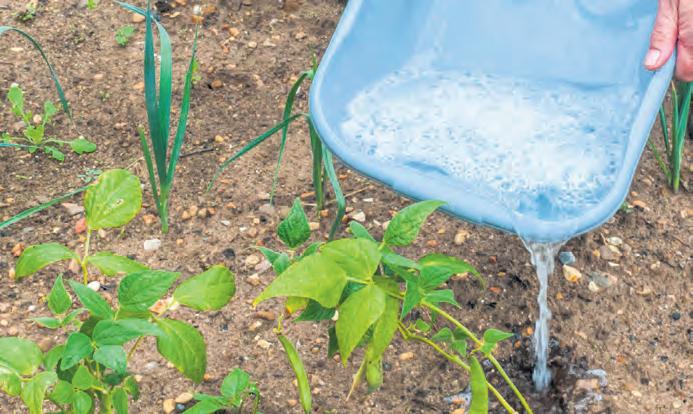
The cost of mains water is constantly rising and during droughts the availability of water decreases rapidly making it harder to meet garden watering requirements.
Grey water is a great alternative and is now being used by hotels, hostels and commercial properties a well as domestic households for garden use.
Grey water has a number of benefits.
• It reduces the amount of fresh tap water being used, lowering water costs
• It reduces the amount of water taken from rivers
• It helps to recharge groundwater levels
• Nutrients are reclaimed and reused helping plant growth
The main problem is the understanding exactly what grey water is. The simple definition is that grey water is water which has been used within the home for tasks such as washing and bathing, food preparation washing up, cleaning and laundry. Every day water is used extensively in bathrooms and kitchens in sinks, baths, showers and washing machines. The amount of water that is used for these tasks is considerable. A household of four people can use 600 litres (130 gallons) or more. The water which would normally just drain into sewers offers great potential.
• Always check the quality of the water you plan to reuse.
• Plant based and biodegradable products are the safest options.
• Do not use water which contains salt, chlorine, phosphorus, bleach, boron or solvents.
• Plants can be harmed or even killed by water that contained bleach or disinfectant. Dishwater and water softener salts in particular can damage soil structure specially in clay soils.
Kitchen waste water produced from washing up dishes and other items is best poured down the drain rather than being reused on the garden. This water is usually very dirty, containing grease, food particles, oil and chemicals.
The final rinsing water can be safely used.
COOKING WATER
Water used for boiling or steaming vegetables is perfect for both indoor and outdoor plants as soon as it is cool enough to touch. It contains valuable nutrients that have leached out of the vegetables and these nutrients can act as natural fertiliser.
Diverter kits are becoming increasingly popular which include valves which can be attached to waste water pipes to allow waste water to be automatically diverted from baths, showers, dishwashers and washing machines. These pipes can be joined directly to hosepipes for watering the garden.
Grey water should never be stored.
At Heathfield Allotment Trust in Devon the trustees were shocked to discover that their soaring water bills were caused by inefficient watering and using tap water more than was necessary. They began actively educating plot holders about how to conserve water and they introduced a requirement that all new sheds and greenhouses must be fitted with a water butt. Leaving the hosepipe on was banned as was the use of sprinklers. The trustees also sought help from South West Water who donated 35 water butts. These were offers to people on the allotments who were not harvesting water. The aim was to ensure that there was a water butt on each individual plot on the allotment. The trustees also provided allotment holders with information on specific watering techniques for each type of crop, for example courgettes require a lot of water compared with other vegetables
The plot holders took the message to heart installing the water butts next to greenhouses, sheds summerhouses everywhere in fact where gutters could be fitted. The overall water bill reduced dramatically with use of water taps limited to the period between March and October.Two plot holders managed to cultivate their allotments for the whole summer without using tap water. Another allotment holder grew melons in her greenhouse using only water generated by rainwater harvesting.
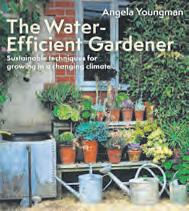

‘The Water Efficient GardenerSustainable Techniques for Growing in a Changing Climate’
BY ANGELA YOUNGMAN
Published by Green Books
(Bloomsbury Publishing)
Paperback: 97881399418645
£20
DEVON WRITER AND GARDENER JOSH CULLUM FINDS SOME SADNESS IN THE ARRIVAL OF AUGUST BUT STILL MANAGES TO FIND LOTS TO DO AND CELEBRATE IN THE GARDEN DURING THE MONTH
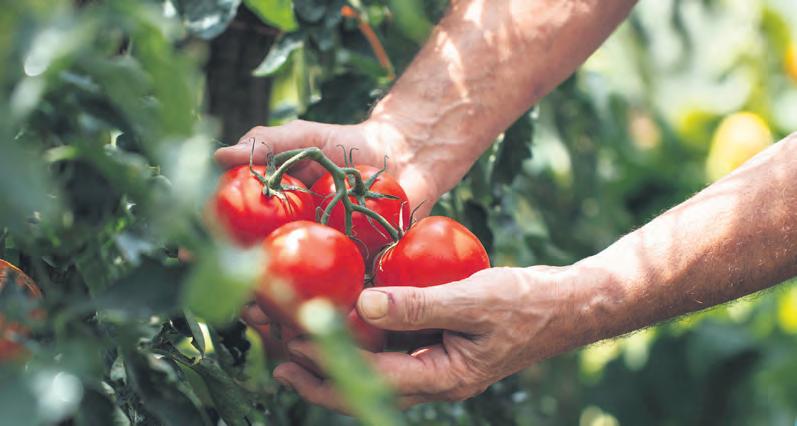
August has been called ‘the Sunday of summer’, and there can be a lazy, idle feeling about the garden. It is the month however when I really try and busy myself. It’s because as a lover of spring with the sense of renewal and vigour I find August something of a bittersweet month.
I struggle to accept the slowing momentum and what I feel is the start of the reversal of the year’s energy.
So, I tell myself there is still everything to play for in the garden and so much to celebrate. Although for the first time you can spot the night’s moving away from those wonderful weeks when its light in the garden at 10pm the nights are still light and balmy. How fresh your garden looks now will depend on how much watering you have been able to do. There has been no rain on my garden for weeks and weeks except about a month ago when there was a mini downpour for about three minutes.
This summer has been very difficult and I personally think it’s been one of the driest for over 30 years.
The name of the game is prolonging the summer display for as long as possible by watering, weeding, deadheading, pruning, clipping, mowing and filling in any gaps that emerge. It doesn’t take a lot of brain power but a degree of tidiness will keep the garden from descending into anarchy.
Above all don’t be despondent and see if you would like to follow my August plan.
Now the garden is in the full glory of high summer ,it’s the perfect time to see what has worked and what you got wrong in terms of planting. So,plan next year while looking at this year -specially spring bulb displays and vegetables.
There’s a lot you can do this month in terms of getting hardy annuals including larkspur, cornflowers, antirrhinum and nigella planted. When it comes to vegetables there’s more salads which can be sown especially salad leaves, radish, rocket, parsley, spring cabbage and winter spinach. Never think it’s too late to take advantage of some good autumn weather and take advantage of the fact that things are still growing.
This is the perfect month for taking cuttings you always promised you would to save money. It’s an easy task and once you try it you can easily get addicted to how great it is on the wallet! The list should include penstemon, berberis, hebe, rosemary, lavender, vibernum, choisya and ceanothus.
There’s a lot which can be done in terms of getting things into containers. Container grown shrubs and perennials require a copious amount of watering to get them settled, which in
my mind is one the most important aspects of growing in containers. The number of plants I’ve seen die because people don’t realise that growing in containers is a very enclosed environment. Plus plant autumn flowering bulbs such as colchicums, autumn crocuses, cyclamen and nerines.
It’s action time for the secateurs probably even more so than in spring so the list should include - wisteria, rambling roses after they have flowered, trained apple and pear trees, lavender, hardy geraniums and lady’s mantle, hedges of most varieties but as late in the month as you can.
One of the nicest words in the gardeners vocabulary when so much of the hard work over the last ten to twelve weeks at least comes good (hopefully) tomatoes, cucumbers, sweetcorn, beetroot, carrots, chillies , courgettes, French beans, runner beans, chard, onions , all sorts of fruit. What a mouth-watering and lovely list. Plus of course remember seeds from flowers as you plan for next year- always a great secret in the armoury of the gardeners.
Jams, chutneys, preserves and pickles. Bag up seeds to give as gifts at Christmas.
Pruning tools, shears, daffodil bulbs, ice cream, sunscreen. Believe it or not August is a good month to plant daffodil bulbs.
Dahlias, sweets pea, zinnias, cosmos gladioli pinks and chrysanthemums.
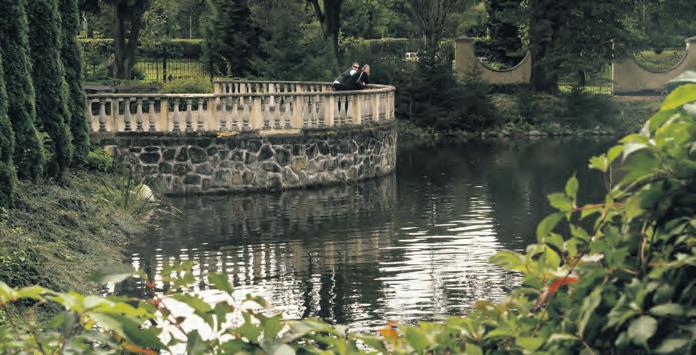
Get out and see as many gardens as you can during the month. It is a great time to see other people’s gardens whether or not those on the wonderful NGS Gardens Open list or any of the great private gardens on the southwest such as Cadhay near Ottery St Mary, or Overbeck’s with it’s wonderful sea views and the organic gardens at Yeo Valley near Bristol, which are my personal favourites. Most gardens will still be full of colours and many in their prime. I find one of the nicest things about this is the numbers of ideas you can gather from seeing what others have been up to.
Finally and most important of all. Above all else if you can’t take a break from the day to day gardening in August then when can you? We all need it from time to time- so take the odd day off and say to yourself I am doing mothering today but just enjoying my garden. You might indulge in picking the odd flower but don’t for one day go near any sort of watering can or gardening tool. And once you’ve enjoyed the single day do it again and again. August is a bit like that.
Enjoy the month!

Visiting gardens in August is a unique and deeply satisfying pleasure. As the peak of summer slowly shifts toward the mellow tones of early autumn, gardens are often at their most vibrant and abundant. The late summer sun casts a golden glow over everything, enhancing the rich hues of blooming flowers, ripening fruits, and lush greenery. It’s a time when nature seems to revel in its own beauty, and visitors can immerse themselves in this fleeting perfection.
The sensory experience of a garden in August is unmatched. Fragrances are thick in the air—lavender, roses, and honeysuckle mingling with the earthy scent of sun-warmed soil. Bees hum busily around late-blooming perennials, and butterflies drift lazily from petal to petal. The warmth of the sun on your skin, paired with the occasional breeze rustling through the leaves, creates a tranquil atmosphere that invites relaxation and quiet reflection.
Many gardens feature seasonal highlights in August, such as dahlias, sunflowers, and hydrangeas in full bloom. Fruit trees may be heavy with apples, pears, or plums, and vegetable plots are often bursting with produce.
Strolling through a garden in August is also a meditative experience. The stillness is soothing, broken only by the sounds of nature—a distant bird call, the splash of a fountain, the rustle of dry grass underfoot. It’s a time to pause and appreciate life’s quieter, simpler pleasures.
Ultimately, the joy of visiting gardens in August lies in their peaceful richness—a final, exuberant burst of life before the fading light of autumn sets in. It’s a moment to savour, deeply and slowly.
August is such a time of fun for families and their four-legged friends at Hartland Abbey. Fans of Malory Towers, now into Series 6, really enjoy searching the house, gardens and walks for all the film locations while parents can enjoy high summer in the gardens.
There are lots of walks through shady woodland, with the deepest blue hydrangeas, to the Walled Gardens and to the beach where scenes from ‘The Salt Path’ were filmed. Displays of annuals in vibrant colours really ‘jazz up’ the kitchen garden.

BBC Television’s Malory Towers has found a home at Hartland Abbey
Travelling theatre comes to the lawns and the tea rooms provide scrumptious homemade lunches, cream teas and enormous cakes!
Hartland Abbey EX396DT Tel: 01237441496/234 www.hartlandabbey.com
The Picton Garden at Old Court Nurseries is a compact horticultural gem. From August into September and October, the garden is one and a half acres of colour thanks to the wonderful collection of Michaelmas daisies which are at their best from 20th September to 10th October. Beyond the daisies is a wealth of autumn colouring trees, shrubs, bulbs, and ferns to add to the interest. The adjoining nursery is well stocked with plants, almost all grown from stock found in the garden, so there is plenty to choose from to fill your own patch with a little autumn joy. Old Court Nurseries, Walwyn Road, Colwall WR13 6QE Tel: 01684 540416 www.autumnasters.co.uk


Tea Room & Walled Garden Nursery WELL BEHAVED DOGS ON LEADS WELCOME

Marwood Hill Gardens is a tranquil 20-acre private garden nestled in a North Devon valley near Barnstaple. Established in 1949 by Dr. Jimmy Smart, this 20-acre garden has evolved into a horticultural haven, featuring three serene lakes, a variety of sculptures, and an impressive collection of plants from around the world including four National Collections, Champion Trees and Marwood is also Camellia Garden of Excellence.
Indulge in homemade cakes and light lunches in the award-winning tearoom, while the plant nursery offers an unusual array of plants for sale.
Enquiries & Tea Room 01271 342528 Plant Sales & Nursery 01271 342577 e info@marwoodhillgarden.co.uk w marwoodhillgarden.co.uk
Marwood Hill Gardens, Marwood, Barnstaple, Devon EX31 4EA

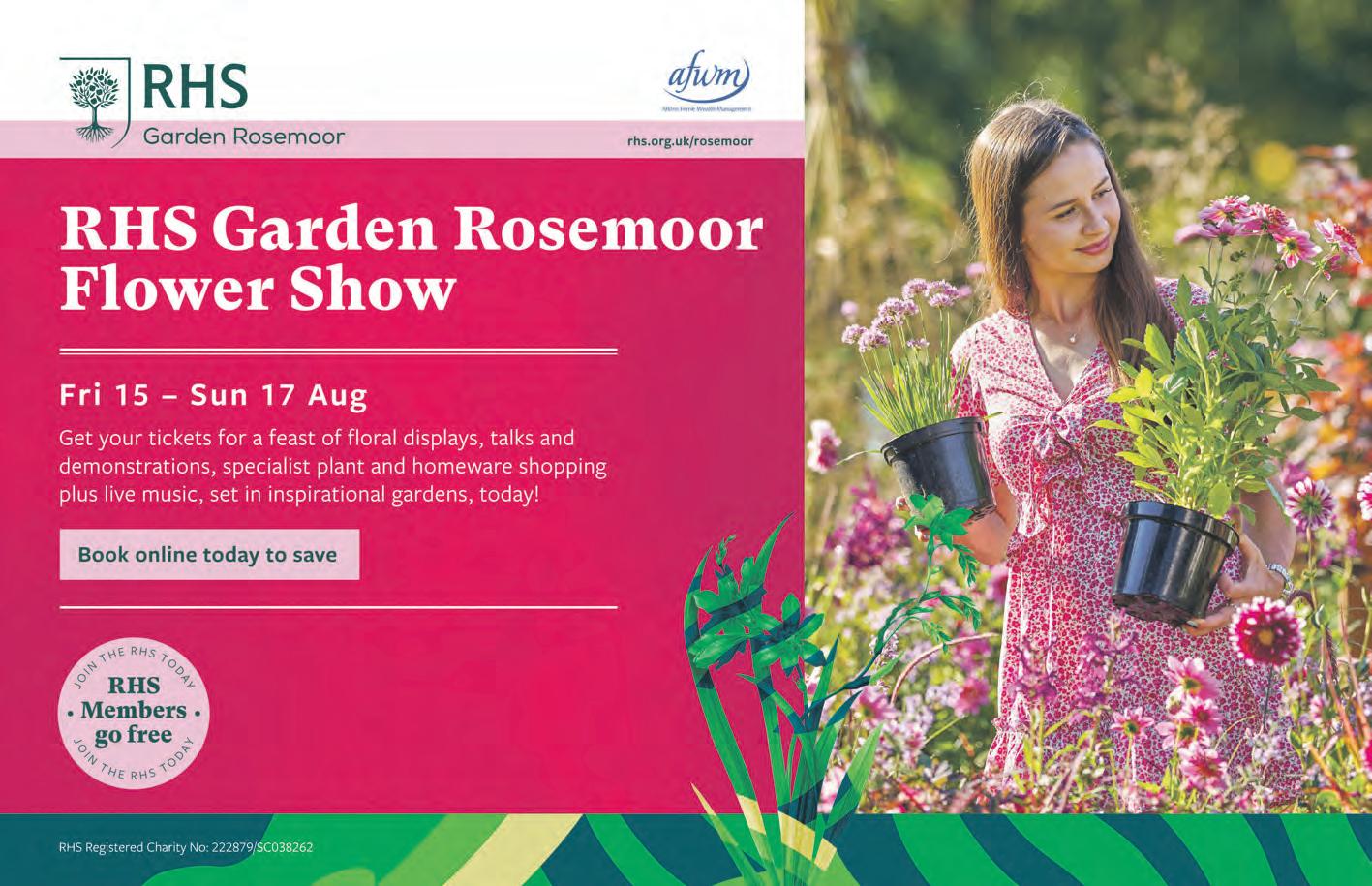
Open Garden Day
Late Summer

Late Summer
Late Summer
Late Summer
Late Summer
Open Garden Day
7th September, 10am-4pm
Open Garden Day
Open Garden Day
Open Garden Day
Open Garden Day
Open Garden Day
7th September, 10am-4pm
Garden tickets: £10 pre-sale or £14 on the gate
7th September, 10am-4pm
7th September, 10am-4pm
7th September, 10am-4pm
7th September, 10am-4pm
Seniors: £7.50 pre-sale or £11 on the gate
Garden tickets: £10 pre-sale or £14 on the gate
Garden tickets: £10 pre-sale or £14 on the gate
Free entry for carers and children under 12
Garden tickets: £10 pre-sale or £14 on the gate
Garden tickets: £10 pre-sale or £14 on the gate
7th September, 10am-4pm Late Summer Tickets and information available at www.badmintonestate.com
Late Summer Tickets and information available at www.badmintonestate.com
Late Summer
Late Summer
Late Summer
Late Summer
7th September, 10am-4pm
Open Garden Day
Open Garden Day
Open Garden Day
Open Garden Day
Garden tickets: £10 pre-sale or £14 on the gate
7th September, 10am-4pm
7th September, 10am-4pm
7th September, 10am-4pm
7th September, 10am-4pm
Seniors: £7.50 pre-sale or £11 on the gate
Free entry for carers and children under 12
Garden tickets: £10 pre-sale or £14 on the gate
Seniors: £7.50 pre-sale or £11 on the gate
Seniors: £7.50 pre-sale or £11 on the gate
Garden tickets: £10 pre-sale or £14 on the gate

Garden tickets: £10 pre-sale or £14 on the gate
Garden tickets: £10 pre-sale or £14 on the gate
Garden tickets: £10 pre-sale or £14 on the gate
Garden tickets: £10 pre-sale or £14 on the gate
Seniors: £7.50 pre-sale or £11 on the gate
Seniors: £7.50 pre-sale or £11 on the gate
Free entry for carers and children under 12
Free entry for carers and children under 12
Free entry for carers and children under 12
Seniors: £7.50 pre-sale or £11 on the gate
Seniors: £7.50 pre-sale or £11 on the gate
Seniors: £7.50 pre-sale or £11 on the gate
Seniors: £7.50 pre-sale or £11 on the gate
Free entry for carers and children under 12
Free entry for carers and children under 12
Free entry for carers and children under 12
Free entry for carers and children under 12
Tickets and information available at www.badmintonestate.com
Tickets and information available at www.badmintonestate.com
and information available at www.badmintonestate.com
Any questions contact the Estate Office on 01454 218203 or email estateoffice@badmintonestate.com
and information available at www.badmintonestate.com
Any
Any questions contact the Estate Office on 01454 218203 or email estateoffice@badmintonestate.com
Any questions contact the Estate Office on 01454 218203 or email estateoffice@badmintonestate.com
Any questions contact the Estate Office on 01454 218203 or email estateoffice@badmintonestate.com
Any questions contact the Estate Office on 01454 218203 or email estateoffice@badmintonestate.com
questions contact the Estate Office on 01454 218203 or email estateoffice@badmintonestate.com
01454 218203 or email estateoffice@badmintonestate.com

Office on 01454 218203 or email estateoffice@badmintonestate.com
or
questions contact the Estate Office on 01454 218203 or
on 01454 218203 or
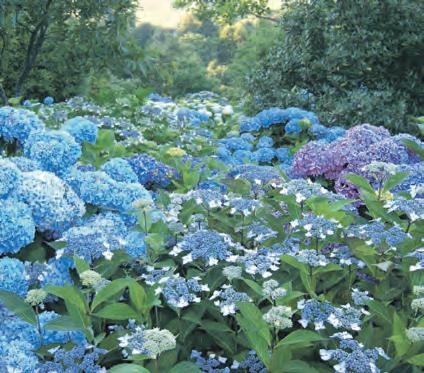
Dramatic pinks, reds, blues and purples of the many hydrangeas light up the far side of the garden this month, as the bushes cascade down the hillside and are a feature of August.
Colour is everywhere. The herbaceous borders sparkling in the summer sun with fiery reds of Kniphofia and Crocosmia, mingling with the heady scents of cool white and pale blue Phloxs, while the emerging dark purple stems of tall Asters and bee covered flowers of Eupatorium create a crescendo of movement and colour.
Around the lakes, late flowering Astilbes and purple Lythrum continue the colourful spectacle for visitors to enjoy the twenty acres that is Marwood Hill Gardens.
The Plant Sales area sells many of the plants seen in the gardens, while the Tea Room provides delicious meals and a welcoming break from a flower filled walk around the gardens.
Marwood Hill Gardens, Nr Guineaford, Barnstaple, North Devon EX31 4EA www.marwoodhillgarden.co.uk Tel: 01271 342 528 Email: info@marwoodhillgarden.co.uk
Kelmscott Manor was the iconic country home of William Morris; poet, designer, craftsman, socialist and founding father of the Arts and Crafts movement. This Grade I listed house was loved by Morris as an example of traditional craftsmanship in harmony with the nearby village and surrounding landscape, towards the very upper reaches of the Thames. Award-winning poet Robert Seatter and acclaimed visual artist Jessica Palmer will bring the fascinating stories and compelling atmosphere of Kelmscott Manor to life as part of the Manor’s programme of learning and public engagement alongside our inspirational new exhibition, ‘A literary man’: William Morris and the Book (open through to 25th October). Kelmscott Manor, Kelmscott, Lechlade GL7 3HJ


GARDENS & TEAROOM
Open every Friday 2pm - 5.30pm from 2nd May to 26th September

Also last weekend in May & August Bank Holiday weekend - Sat, Sun & Mon GARDENS: adult £6, child £1
CADHAY, OTTERY ST. MARY, DEVON, EX11 1QT 01404 813511 www.cadhay.org.uk Member of Historic Houses

Open only three times a year, the private gardens of Badminton House will next be showcasing the beautiful late summer flowers on 7th September. Visitors can discover the historic Badminton House gardens, featuring formal beds designed by renowned landscape architect Russell Page and François Goffinet. Wander through the South Garden’s water squares, hedges, and borders, then visit the Walled Garden, home to the estate’s kitchen garden and a beautiful wisteria walkway. Enhance your visit with plant stalls, delicious food and drink vendors, and don’t miss the exhibition A Garden of Botanical Art in the Old Hall. Proceeds will support the Severn Area Rescue Association and the Church Restoration Fund.
The Badminton Estate, Badminton South Gloucestershire, Badminton GL9 1DD. For more information visit www.badmintonestate.com
One of the most popular plant sales in the Cotswolds returns on 6th and 7th September when West Kington Nurseries hold their autumn plant sale. Entry over the two-day event is free and visitors will have the chance to wander over the five acre site of the nursery which promises to be bursting with plants. Catalogues for the sale are sold in aid of local charities. West Kington Nurseries, West Kington, Chippenham SN14 7JQ Call 01249 782822 or visit www.wknurseries.co.uk for more information.

We produce and grow the largest selection available in the UK. Plants are pot grown and suitable for garden, patio or bonsai.
Visitors welcome Mon-Sat 9am-1pm & 2pm-4pm
Barthelemy & Co (DCG), 262 Wimborne Rd West, Stapehill, Wimborne, Dorset BH21 2DZ
Tel: 01202 874283
enquiries@barthelemymaples.co.uk www.barthelemymaples.co.uk

Oak Fair is a celebration
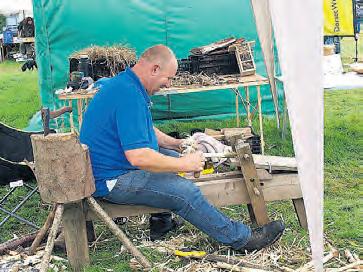
A celebration of countryside, woodland, timber, traditional craft and above all, conservation, the Oak Fair has something for everybody over two days on August 23rd and 24th. With over 200 exhibitors showing everything from handcrafted wooden furniture to industrial machinery, the Oak Fair provides a platform for rural crafts and countryside conservation. It opens at 10am.
Demonstrations include the ever-popular chainsaw carving, falconry, heavy horse logging, and the daredevil stunts of the Adams Axemen display. Get involved with hands on activities including scything, willow sculpture and archery, and children’s activities including bushcraft skills, face painting, tree climbing and tractor & trailer rides. Early bird tickets: £14 adults, £2.50 children, children in prams go free, £10 concessions. Stock Gaylard Estate, DT10 2BG www.theoakfair.com
Barthelemy & Co from Wimborne in Dorset was established by a French nurseryman almost a century ago and the Skinner family now specialise in propagating and growing acer palmatum – or Japanese maples as they’re known.
Throughout spring, summer and autumn the delicate foliage of the acer presents exquisite shadings of Mother Nature’s gold, pink, purple, green, yellow, orange and red. Acers are a delightful addition to anyone’s garden, giving an aura of peace and tranquillity. The ten-acre nursery at Stapehill has a huge collection of Japanese maples to choose from and expert staff are on hand to help select the right variety and to offer advice about caring for the trees in future. Over 100,000 acers are produced at every year approximately 10,000 - 12,000 of them are grafted named palmatum varieties, as one of the largest specialist growers of their kind.
Barthelemy & Co, 262 Wimborne Road West, Wimborne, Dorset BH21 2DZ Tel: 01202 874283 www.barthelemymaples.co.uk



Early September date for Forde Abbey plant fair
Forde Abbey’s Autumn Plant & Gardening Fair, held on Saturday, 6th September, is a highlight for the popular garden on the Somerset and Dorset border. The event celebrates the shift into autumn, with foliage turning warm and the air crisp—a perfect backdrop for plant enthusiasts. From 10.30 am to around 3pm, visitors can explore a number of speciality plant nurseries many back by popular demand. You can enjoy coffee and cakes at the Abbey’s Coffee Shop, open from 10.30 am to 4.30 pm. An entry fee of £7.50 grants access to both the fair and the award-winning gardens; entry is free for Abbey members, and parking is complimentary. Complementing the fair is the Forde Abbey Fruit Farm open daily from 9.30am to 6pm, weather permitting This ‘pick-your-own’ orchard invites families and visitors to gather apples, pears, and soft fruits straight from the trees. The fruit farm is part of the estate’s diversified 1,600-acre operation. Together, the Autumn Plant Fair and fruit farm offers an early autumn welcome at one of England’s finest historic estates. Ford Abbey Estate, Chard TA20 4LU
Want to advertise in one of our features?
We offer special all counties prices when advertising with our features, plus 100 words of free editorial with an advert. Speak to one of our sales people for more details.



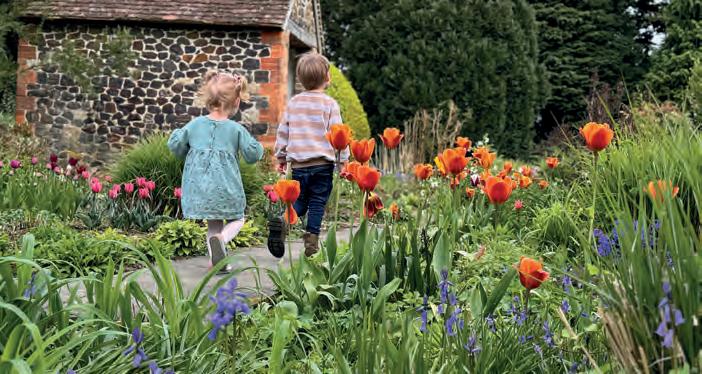

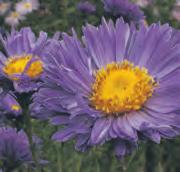

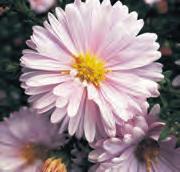
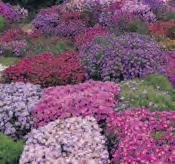




WALKS Visit our fascinating family home with its beautiful Walled and Woodland gardens, Fernery and Bog garden, walks to the Atlantic Coast, stunning architecture, collections, displays and film exhibition. Location for Enid Blyton’s ‘Malory Towers’, ‘The Night

The RHS Garden Rosemoor August Flower Show—set in a stunning 65 acre Devon valley—returns as the region’s only combined RHS flower show over three days this August. From 15th–17th August, this event unfolds across formal borders, woodland walks, and Lady Anne’s Lawn, offering something for every garden enthusiast.
At its heart, the show is a vibrant marketplace of over 20 specialist nurseries showcasing high quality plants: perennials, shrubs, grasses, houseplants, and ornamentals.
Demonstrations and talks take place in the Talks Tent and Garden Room. Notable speakers include herbalexpert Jekka McVicar, houseplant guru Joe Bagley, and celebrated broadcaster Carol Klein, who will launch her memoir, Hortobiography Floral art enthusiasts can watch NAFAS
demonstrators—like Angela Turner and Coral Gardiner—craft stunning designs using seasonal, locally grown flowers.Floral arranging demos by experts such as Jonathan Moseley happen twice daily, giving visitors inspiration and the chance to witness hospitality in action. Practical amenities include well-managed parking and a shuttle from Great Torrington. Early Bird tickets allow entry an hour before the public, easing access and offering first pick from the stalls. Tickets from https://www.rhs.org.uk/gardens/rosemoor/ rhs-garden-rosemoor-flower-show
RHS Garden Rosemoor, Torrington EX38 8PH
The RHS gardens are trialling a ‘paws on paths’ pilot to assess the level of demand for increased access for dog owners until 17th September. Dog owners are asked to keep to paths and off lawns on the 65-acre site. However, in the summer heat, these constraints can be an issue for pets. A new leaflet provided on entry now highlights the areas of the gardens that offer plenty of shade to ensure paws are protected when temperatures rise. The map also shows another shorter and fully accessible route suitable for visitors with less time to spare or looking for easier dog walks.
Visiting a National Garden Scheme garden isn’t just for adults – there’s plenty of fun (and homemade cake) to be had during the school holidays at our gardens for children too. And, with children going free at most of the gardens, a day out at a National Garden Scheme garden is great way to have a budget-friendly break from digital devices, reconnect with nature and support great causes! Find a garden to visit near you:www.ngs.org.uk
The Cadhay gardens are looking magnificent this year and the allotment holders have excelled themselves. The Dahlia collection will be at its best in August adding even more colour. Throughout August the gardens are open every Friday afternoon from 2pm till 5pm and Saturday, Sunday and Monday afternoon of the Bank holiday weekend 23rd-25th August when they will be open in aid of Hospiscare on the Saturday and the NGS on the Sunday and Monday.
Cadhay EX11 1QT is one mile to the north of Ottery St Mary.
See cadhay.org.uk for further details.


Deborah Alway was a committee member of her north Somerset gardening club for ten years before it closed two years ago. She is now with others trying to re-instate it but is finding it tough going.
It has been over two years since our village gardening club closed.
We live in a small village community with a population of just over 550 and in the past have been able to sustain a successful gardening club with about 80 members and 30 to 40 attending monthly meetings.
Covid did real damage. I know from talking to other gardening club members those two years when it wasn’t possible to hold meetings was we now know a serious blow to gardening clubs throughout the country. They lost identity. Members felt they didn’t need the club any more and membership tailed off through apathy and to be honest some poor visiting speakers from time to time. We tried to soldier on for a couple of years, but it wasn’t the same.
The club used to hold a village produce show every in August and it was a lovely event with lots of competition classes and tables full of vegetables, craft and flower classes but interest in that faded - even before Covid.
Alongside the trauma of Covid lockdown the standard of our visiting speakers dropped and as this is the focal point of meetings members lost enthusiasm. We didn’t spend enough money to get decent speakers to our meetings.
Some speakers short changed us- speaking for about 20 minutes. Others didn’t know their subject or were poor speakers and some we chose the wrong talk. I remember one called ‘Travelling the hills around Rome’ was memorable for the wrong reasons.
But the new committee felt we had learned our lessons.
This March there seemed to be some enthusiasm for trying again. I don’t think gardening is less popular than it was a couple of years ago. In fact, just the opposite. It was a real campaign in the village to bring the gardening club back. So far, we don’t have the support. I read the other day that clubs in rural areas are in decline while those in cities are experiencing growth.
In our village I think we all know the reasons why it’s difficult to restart the club. There’s an ageing population and that means it is more difficult to get out and to get enthusiasm going.
There are new families but they don’t seem to have the time with ‘taxi services’ and the pressure of raising young children a full-time task.
We have tried to engage younger people, but they politely decline.
There is also a change in lifestyle which has affected gardening clubs.
Here in the village there’s a lot more leisure interests and things going on from yoga to pilates to bowls and supper clubs which there probably wasn’t a few years ago.
I approached the RHS which has highlighted the need for gardening clubs and offered support with ideas for membership but a lot of their attention is focussed on cities where there is an understandable interest in community gardening and local food production.
We will I think try again next spring and see if we can get the club going but for the time being I think it is a sad loss to our village life.
Deborah has asked us to keep the name of the club out of her letter. She says there is still a chance that it can come back and doesn’t want to jeopardise that.
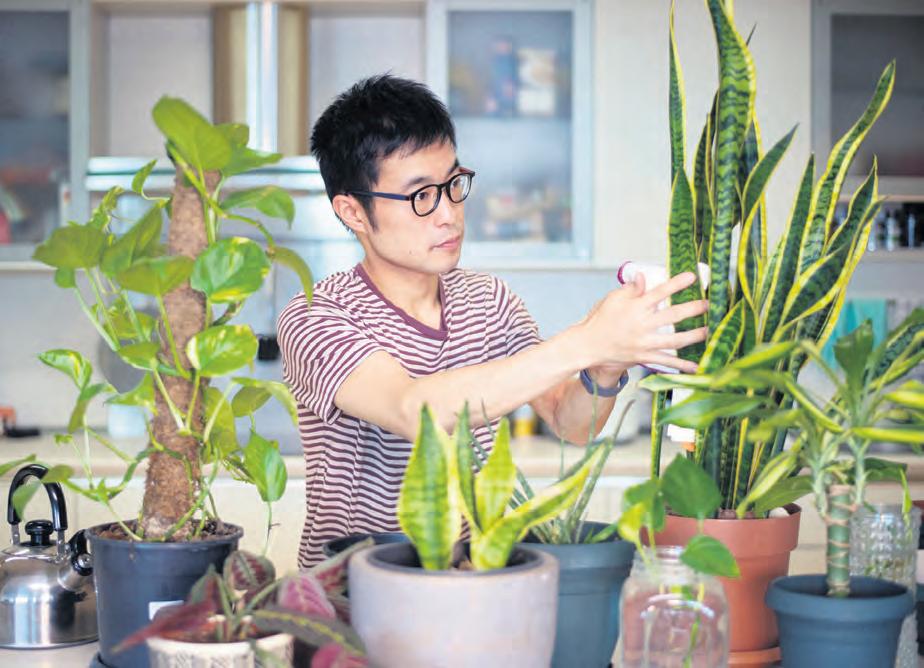
A lot of houseplants are killed by kindness – or lack of knowledge about the plant. You should never let your plant sit in water continually. The best technique is to put about an inch of water in your sink and then let your plants sit in it. After an hour and once they have absorbed what they want you can take them out. The secret about houseplants is generally don’t fuss over them moving them into sun or shade or vice versa. They are generally great survivors.
How often do you see huge trees in someone’s front gardens taking up space and light. Conifers, oaks, Norway maples invade important spaces. There are lots of smaller more modest trees which look stunning, colourful and won’t dominate space. Pencil cherries often called flagpole cherries because of their slim build and gorgeous and provide tons of colour. Weeping pear and weeping cherry are other great smaller options. And of course, there’s the striking Japanese maples. Any of these options will make better use of space. It’s important that when you buy a tree check on what size it will be in 20 years time and don’t forget how fast trees grow!
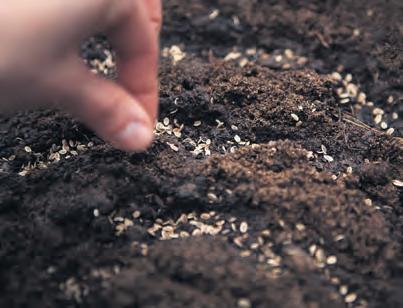
Growing from seed is one of the great pleasures of gardening. It’s easy and relatively cheap.
The danger is the numbers game. If you get 300 seeds in a packet its very tempting at the start of a season to envisage lots of plants in a few month’s time and plant the lot. What you don’t think about is the implications of all those seeds in terms of time, patience, space and compost.
One of the lost common gardening mistakes is planting too many seeds at one go. How many of us have planted lots and lots of tomato seeds only to see the majority of them go to waste. The message is sow little and often.
Planting too deeply is a very common mistake which ruins lots of plants and it is a reason why many don’t survive. If you are repotting into the garden make sure the plant is at the same level as it was in the pot. This means above ground level if you plan to mulch (and you should mulch to help preserve moisture and keep down weeds .Pay special attention to trees. The root flare where the base widens slightly should be above ground. A tree should not look like a telegraph pole coming out of the ground. Typically larger seeds prefer deeper depths of planting and smaller seeds closer to the top but this is not always true. Don’t make the mistake that all seeds should be planted at the same depth.
It might sound obvious but always read the label of any plant or shrub you buy before planting. The information on these labels is there to help and it should normally let you know about what soil is needed, the future size of the plant and growing conditions. Too often gardeners just throw the plant in and ignore what is after all expert advice.
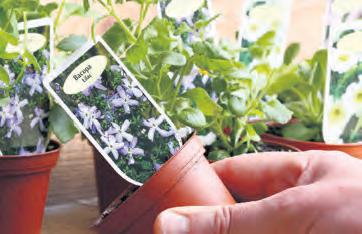
We all make gardening mistakes but former head gardener Sarah Farrell who has now retired to her Devon allotment has a list which she thinks most gardeners are guilty of
Don’t use a hoe all the time to chop the top off weeds. Many weeds in the garden such as dandelion, thistle have a very strong root structure under the soil. There are weeds which like it or not you have got to get out the spade and dig out
Most people water at the wrong time. They water when it is convenient to them and not the plant. The best time to water plants is typically in the morning. This allows plants to absorb the water throughout the day, and the foliage and soil surface will dry out more quickly, reducing the risk of fungal diseases. If you can’t water in the morning, late afternoon or early evening is the next best time. Avoid watering during the heat of the day, as much water will be lost to evaporation. And be as accurate as you can when watering. Don’t throw the water over the whole plant. Tomatoes can be damaged with too much water on the leaves. Direct watering with a can to the roots of the plants
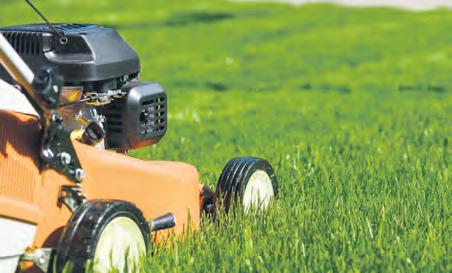
Cutting grass too short exposes the soil to sunlight and can lead to soil erosion, especially during heavy rains. It can also promote the growth of undesirable plants.
Short grass is more susceptible to disease and pests. Depending on how short you cut it, it could take up to three weeks before your lawn recovers completely. If you can’t wait and want to seed certain areas of your lawn, you can check this guide on the best ways to grow grass fast.
Growing vegetable is fun but it should also be an important part of the family budget saving money and providing freshly picked fruit and vegetables. But don’t be tempted to grow things you might like growing which no one eats. A recent survey showed that the most profitable things to grow in the vegetable patch were leeks and asparagus mainly because they were so expensive in the shops.
Don’t be tempted into thinking that plants need feeding all the time. It’s true that feeding will help tomatoes and roses for example but not all the plants in the garden need help and it can be a very expensive move.
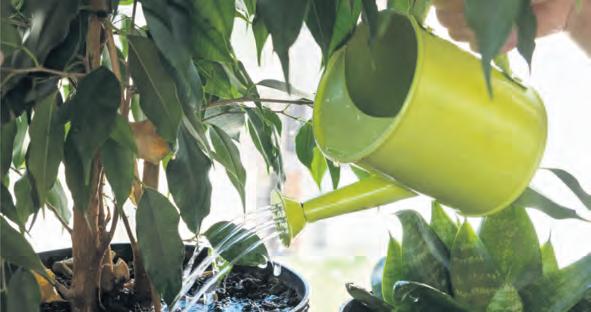
Guest speakers are an asset to gardening clubs, bringing fresh perspectives, specialized knowledge, and renewed inspiration to members. Their expertise can cover a wide range of topics, from organic gardening and pest control to rare plant species and sustainable landscaping.
For the second year running gardening clubs throughout the south and southwest have been building back member numbers after the Covid shutdown of a few years ago which dealt a body blow to so many clubs.
So the importance of guest speakers has never been more critical in attracting members to meetings.
One of the greatest benefits guest speakers offer is their ability to introduce new techniques and trends. Whether it’s hydroponics, native planting, or permaculture, a speaker can spark curiosity and encourage gardeners to experiment with innovative ideas.
Moreover, guest speakers can reinvigorate interest and attendance within a gardening club. A well-promoted talk by a
knowledgeable or well-known expert can attract both current and prospective members, increasing club visibility and membership. Their presence adds credibility and variety to the club’s programming.
Ultimately, guest speakers bring vitality and growth to gardening clubs—not just for the plants, but for the people involved. They educate, inspire, and connect members in meaningful ways, making each meeting more than just a routine gathering—it becomes a true learning experience.
Every August Country Gardener has been delighted to produce an effective list to provide an invaluable aid for speaker options, ideas and subjects to gardening clubs. We have full details on each speaker including a synopsis of the subjects they talk on, what they charge and how far they are willing to travel.
If you come across speakers who you have been impressed with let us know and we will try and include them in a future issue of the magazine and update our online information.
Welcome to Country Gardeners’ annual guide to gardening speakers and lecturers offering their services to gardening clubs and associations.
ALEXANDER, ADAM
Benson Bush, Itton, Chepstow, NP16 6BZ
q 07860646613
E adam@theseeddetective.co.uk
Ħ www.theseeddetective.co.uk
1. MEETINGS WITH REMARKABLE VEGETABLES – the journeys from wild parent to cultivated offspring
2. ADVENTURES IN ALBANIA – a journey into botanical diversity and wonderful fruits and vegetables
3. THE ADVENTURES OF A SEED DETECTIVE – finding rare and endangered vegetables around the world
4. THE CULTURE OF SEED SAVING – it’s easy and fun to continue a 12,000 year-old tradition.
5. ETHIOPIA – discovering crop diversity and what traditional horticulture has to teach us about growing at home.
6. THE GARDENS OF THE MEKONG – A voyage of discovery revealing the secrets of growing along the river bank
7. THE SEED SAVERS OF RAJASTHAN –Uncovering the surprising world of delicious local varieties.
8. THE GARDEN ABOVE THE ESTUARY – Creating a space to grow rare, delicious vegetables for seed.
Adam, who has grown vegetables since a young boy is a consummate and entertaining storyteller, author and producer of food and gardening programmes. He has appeared on TV including Gardeners World and collects rare and endangered vegetables from his travels, saving and sharing seeds.
B
D www £D BROOMFIELD, PHIL q 07810 646123
E info@philbroomfield.com
Ħ www.philbroomfield.com
1. Merton’s Dream Garden: The Story of the Russell-Cotes Garden
2. Architecturally Eccentric Follies & Grottoes
3. Thomas Hardy’s Gardens: A study of Hardy’s Cottage & Max Gate
4. Highcliffe Castle: A Garden by the Sea
5. Brick by Brick: Dorset’s Walled Gardens
Phil is a professional gardener based in Bournemouth, Dorset.
1 BroomHill Cottage, Broom Hill, Huntley GL19 3HA q 01452 830 258 E woodmansworld@live.co.uk
1. Trugmaking by a miserable old trugger - I think that’s what the wife called me
2. Besoms and Gypsy Flowers
3. Bees and their products D £B
35 Wembdon Rise, Bridgwater, Somerset TA6 7PN q 01278 451814 / 07788593674
E rvcheek@btinternet.com
1. Chelsea Flower Show - Creating 20 different silver and gold gardens and displays.
2. Irresistible garden plants for Butterflies - Bringing them winging in by adding carefully chosen plants.
3. Insectivorous plants - Discover new hardy year round attractive ones for the garden or the windowsill.
4. Fascinating Gardens - Choose from 50 regions worldwide from Cornwall to Costa Rica.
5. Holly and Ivy - Fascinating new kinds and uses and entertaining finale.
Many other talks, ask for details. Widely experienced and qualified, Roy progressed from Gardener to Director of parks and gardens around Britain. As senior lecturer and curator of gardens in Somerset he amassed ten thousand different plants, ten national collections and created new hybrids, diverse gardens and gold medal exhibits at Chelsea.
Now Chairman of an RHS trials forum, international tour leader, judge, advisor, designer and writer.
Corner Cottage, Great Street, Norton sub Hamdon, Somerset, TA14 6SJ q 07594 574150
E info@katherinecrouch.com
Ħ www.katherinecrouch.com
1. New Tricks for Old Gardeners
2. Plants That Should Be Better Known
3. Grow the Food You Can’t Buy
4. The Self Seeding Garden
5. Hardy Exotics Plants – will they suit your garden?
6. Bulbs that Should be Better Known
7. Ornamental Grasses in the Garden
I am a garden designer in Somerset, a life long country gardener, BBC Gardener of the Year 1999. BBC Gardener of the Decade 2008, Chelsea Gold Medal winner 2013. My talks are entertaining as well as informative – nobody will be asleep at the end!
Keyford, Frome q 0780 120 3292 E dawn@dawnadenton.com Ħ www.dawnadenton.com
1. Growing up in Apartheid South Africa
2. The British 1820 Settlers to South Africa
Dawn A Denton is a tour guide, teacher, writer and professional speaker who shares powerful stories of South Africa’s complex and compelling past.
Former owner of Cleeve Nursery q 07739 977431
E downtoearthfd@gmail.com
Ħ www.down-to-earth.co.uk
1. Climbing and Wall Plants
2. Great Foliage Plants
3. All Year Fragrance in the Garden
Please contact me for the full list.
B £B
www
HAMPSHIRE HAWK WALKS
69 Winchester Road, Four Marks, Hants GU34 5HR q 07970 727539
E anita@hampshirehawkwalks.co.uk Ħ www.hamphirehawkwalks.co.uk
1. From gardener to falconer and how a Harris hawk changed my life - An interactive talk with birds of prey in attendance.
A factual insight into falconry and birds of prey, what it is like to work with these amazing creatures on a daily basis and the opportunity to see them up close while I tell you all about them.
Buckfastleigh, Devon q 07753231132
E jacquiefelix@gmail.com
Ħ www.oasisgardendesign.co.uk
1. Principles of Garden Design
2. Designing a Garden with Pots, Containers & Raised Beds
3. Bespoke Talks
I give talks for Garden Festivals and clubs; hosted at RHS Chelsea; written and featured in national publications & contributed to BBC Gardeners’ Question Time
A www £B
17 Thorn Close, Exeter, Devon
EX1 3HW q 07717 846814 / 01392 437792
E becca.redkite@gmail.com
Ħ www.rowanleaf.co.uk
1. Wildlife Gardening - Attracting beneficial wildlife to your garden
2. Water, Water Everywhere - Ponds, bog gardens and water-wise gardening
3. The Best Of Friends - Companion planting techniques for a healthy, productive garden.
LADY HORTICULTURIST
32 Addison Close, Exeter EX4 1SJ q 07720714720
E ladyhort824@yahoo.com
C
Ħ www.ladyhorticulturist.co.uk
1. Women in Horticulture - past and present
2. Pots and Baskets
3. Other talks available
Claire Forster CMTGG (Consultant member of The Gardeners Guild), qualified RHS Certificated Horticulturist with RHS Level 3 Advanced in Horticulture. Specialist in Garden Restoration. 20 Years professional horticulturist experience. Featured in Devon Life Magazine.
B www £B
Award Winning Garden Designer
20 Sandhurst Road, Yeovil, Somerset BA20 2LG q 07899710168
E juliesandhurst1@gmail.com
Ħ www.sandhurstgardendesign.co.uk
1. Container Planting
2. Planning your Garden Borders
3. An Introduction to Garden Design
4. Going for Gold - Exhibiting Show Gardens at RHS Chelsea Flower Show, BBC Gardeners’ World Live and Taunton Flower Show
www
Office F11, 10 Whittle Road, Ferndown, Dorset, BH21 7RU q 01202 876177
E enquiries@treeadvice.info
Ħ www.treeadvice.info
1. The Churchyard Yew
2. Trees in your Garden
3. Trees and the Law
Please contact us to discuss requirements.
C
Netherfields, Frog Lane, North Nibley, Glos GL11 6DJ q 07876 196074
E margiehoffnung@gmail.com
1. A Flower Farmer’s Year - Frog Lane Flower Farm - what it takes to bring you fabulous, chemical free, sustainable, seasonal flowers.
2. Rosemary Verey - Her Contribution and Legacy to C20th Gardening.
3. Garden Visiting - A Very British Tradition - a light-hearted look at the many different aspects of why we visit gardens.
4. Westonbirt School - A Historical Introduction to the Gardens and the Holford Legacy.
B www £C
Malmesbury, Wiltshire q 07711285447
E info@nicolahope.co.uk
Ħ www.nicolahope.co.uk
1. Designing an Organic Garden
2. No-Dig and Polyculture in your garden
3. Every Garden Matters - a blueprint for boosting backyard biodiversity
4. Tales from the Potting Shed ~ where gardening magic begins!
5. Talking Tomatoes ~ Seeds with Stories make Tastier Fruits
B £B
Great Torrington, Devon, EX38 7DN q 07810445241
E ric@rjhorticulture.co.uk
Ħ www.rjhorticulture.co.uk
1. Understanding Design Principles
2. Garden Assessments: Interpreting & Improving your Garden
3. Tree Climber to Garden DesignerMy Journey
4. Mastering Garden Maintenance
5. Reviving & Evolving an NGS Garden
Covering Devon, Cornwall and Somerset
Please get in touch for further information.
B £D
1 Stanley Cottages, Blaisdon Longhope, Gloucestershire GL17 0AL q 077 66 197 129
E nmignotte@aol.com
1. Gardens of Versailles
2. Islamic Gardens
3. Medieval Gardens
4. Landscapes of Vietnam and Cambodia
5. Le jardin Majorelle in Marrakesh
6. Landscape and Flora of Hokkaido
Please, feel free to contact me for more information on the above talks as well as on other topics. I base my presentations on personal experience, photography and travels in Europe and Asia.
Travel charges and fee on request. Thank you.
Instagram: @nahemi25
Facebook: Nathalie Mignotte - Guest Speaker and Horticulturist
B £B
Slades Cross, Combe St Nicholas, Chard TA20 3HQ q 07719 362279
E sally.nex@btinternet.com
Ħ www.sallynex.com
1. Gardening without Plastic
2. How to Garden the Low Carbon Way
3. Peat-free gardening
4. Rewilding Your Garden
5. A World Under Our Feet (soil care)
6. Heritage Vegetables
7. A Rogue’s Gallery for Gardeners (sustainable ways to tackle gardening problems)
D
£D
Swallows, Withleigh, Tiverton, Devon EX16 8LA q 01884 242965
E stephen@stephenpowles.co.uk
Ħ www.stephenpowles.co.uk
1. Hedgehogs - In Need of Your Help
2. Otters - Coming to a River Near You
3. Hammer Scar - Five Years Together (all about the five years Stephen spent filming one individual otter in amazing detail)
4. Tawny Owls - Coming to a Wood Near You
5. Hornets - Gentle Giants
6. Wildlife Photography - Tips and Experiences
7. The Countryside Detective
SHELDRICK, CAROLINE
Middle Path, Keble Road, France Lynch, Stroud GL6 8LN q 01453 884092
E cjsheldrick@gmail.com
Ħ www.carolinesheldrickmedicalherbalist.co.uk
Caroline gives entertaining and informative illustrated talks on:
1. A year in the cutting garden
2. Health from the hedgerow
3. Medicinal plants in the garden
4. Flowers in healing
Caroline is a semi-retired medical herbalist, and grows plants and flowers for cutting.
Droitwich Spa, Worcestershire q 01905 928438
E hello@pipsmith.co.uk
Ħ www.pipsmith.co.uk
1. The Fragrant Garden
2. The Resilient Garden – ‘Drought’ or ‘Flood’
3. Garden Design Tips & Tricks
Visit website for more talk titles. A former Head Gardener at Wollerton Old Hall (Shropshire), Pip now runs his own garden design studio in Worcestershire.
TOLMAN, ANDREW
Malmesbury, Wiltshire
E atpgardening@gmail.com q 07546874083
1. Off the beaten track, hidden gems
2. Stumperies, ferns & shady friends
3. Art of Topiary & Ornamental Hedges
4. Glorious gardens, a gardeners choice
5. A Winter’s Tale from Sept 2025
PLEASE REMEMBER TO CHECK THE COVERAGE AREA OF THE SPEAKER BEFORE CONTACTING THEM.
If you would like to be part of our hugely popular Speakers List next year, email: classified@countrygardener.co.uk
10 Rowbarton Close, Taunton, Somerset, TA2 7DQ q 01823 278037 E dave.usher@hotmail.com
1. Gertrude Jekyll - Her Plants & Designs.
2. The Restoration of Hestercombe Gardens
3. Bedding Plants for your Gardens
4. Care and management of trees & shrubs
5. The history of our gardens
6. The answer lies in the soil
7. Herbaceous Plants
8. 10 Top Tips for a tip top garden
David, a professional gardener for over 50 years, was Head Gardener at Hestercombe for 18 years. He is interested in all aspects of ornamental gardening and has given talks to a wide variety of groups. Contact him for a brochure about his talks. David is also available for giving talks via Zoom.
Stockton Bury Gardens, Kimbolton, Leominster, Herefordshire HR6 0HA q 07880 712649 E twstocktonbury@outlook.com Ħ tamsinwesthorpe.co.uk
1. Life as a garden writer
2. Planning for the season ahead (practical tasks & plants)
3. Understanding the RHS Judging process
Tamsin is a popular speaker at home & abroad. Curator of Stockton Bury Gardens, a garden writer & RHS judge with 30 years’ experience.
www
14 Mill Park, Newent, Gloucestershire GL18 1EX q 01531 828625 / 07767 690009 E mail2@thegardenlady.me.uk Ħ www.thegardenlady.me.uk
1. Planting and Plant Care
2. How to love your garden
3. Design and Create a Garden to be Proud Of
Many other talks available, please ask for more details.
17 Seymour Drive, Torquay, Devon, TQ2 8PY q 07964 824673 E info@garden-together.co.uk
1. Camellias
2. The Scented Garden
3. History of TEA
Ex Head Gardener of private estates and now specialist camellia grower of over 500 varieties and a wide range of fragrant plants. RHS Chelsea Flower Show Gold Medallist
If you have any correspondence you would like to share with Country Gardener then email us at editorial@countrygardener.co.uk
I was interested to read about the work at Bristol University concerning the availability of nectar sugar in our gardens and the observation that flowers with long corolla tubes such as salvias are only accessible to insects with long tongues. This summer our garden borders are alive with the sound of bees including a clump of salvias. I had a close look and saw the bees were being very versatile and getting the nectar by probing at the base of the corolla. The stems were weighed down by the weight of the bumblebee on the flower. How enterprising!
Caroline Swann Portishead
£2,134 saved by growing my own
I heard on the radio the other day about how carrot leaves were an important crop and they mentioned how edible the leaves were. I have heard this elsewhere that carrot tops are important and they have since become a favourite with my family and no one has come to any harm by us cooking them. We now always keep the carrot tops. They are strongly flavoured.
Sam Greene Petersfield
This is going to sound very nerdish but however, I am recently retired and find myself with a lot more time on my hands, a lot of which I devote to the garden and an increasing passion for growing vegetables and a wide variety of vegetables. So I have had the time I am embarrassed to say, to record and weigh and then find the equivalent supermarket cost of the vegetables I have grown. I did this for a whole season and am about to repeat the exercise this summer. Your readers might be surprised to hear the savings in vegetables I have grown for just the two of us with some surplus for family and friends. The total savings came to £2,134 for the season. So, growing your own saves on your purse and perhaps helps the planet.
Derek Thornton Somerton

I read with interest your article about efforts being made by local authorities to improve the look of front gardens and to stop them just being car parks. When I lived in a 1970s terraced house everyone had immaculate lawns and flower beds either side of the path to the front door. Now that has all gone. I also think these gardens added to not just the look but the value of the property. Nine out of 15 front gardens near me have decided to sacrifice their front garden to park their cars.
Gilly Foster Bideford
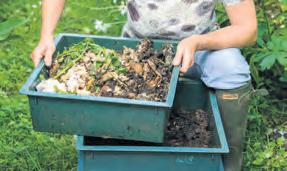
I had this plant pictured below in my conservatory for more than 20 years. It has big leaves, long thin stems and has quite a spread. Recently I noticed two buds on its which grew gradually bigger by the day until amazingly it flowered one night for the first time ever. I have since discovered it is called Epipohyllum oxypetalum also known as queen of the night. It is I understand a rare species of cactus that rarely blooms and only opens at night. Its flowers open at dust and close again in the morning. I feel very privileged to have it.
Gilly Foster Bideford
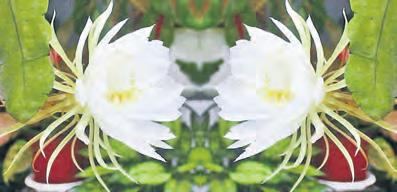
I think wormeries seem to be making a comeback. Do you remember when we all had them? I now run two wormeries which process most of our kitchen waste material of teabags, vegetable peelings, paper, cake cases, salad trimmings and more. I add chopped up green cuttings, spent compost eggshells and even torn up egg boxes and newspaper to help with the moisture. The worms reward my efforts with dark crumbly moisture at an alarmingly fast rate during the warmer months. I use it to mix my own posting compost and improving the soil in the vegetable beds. A couple of handfuls complete with worms can really help to pot a plant, they tunnel down dragging the compost with them aerating and improving the root environment. They seem to have gone out of fashion but I hope more gardeners take the time to learn how to use a wormery to dispose of waste material.
Lucy Mannigan Yeovil

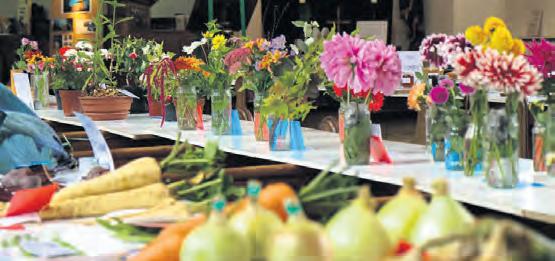
end of flower and produce shows - 1
Sadly, flower shows seem to be in a terminal decline. The one organised by our local gardening club came to an end a few years ago and now I read of two more in local villages are not going to happen anymore. It made me think when my father and grandfather used to exhibit in flower and vegetable shows in Devon and Dorset. Not only were there annual and seasonal shows but before the Second World War there were monthly flower shows in the Somerset village we used to live in. I still have some of the certificates my father and grandfather won (for marrows, pumpkins and dahlias mainly) and I guess it is now a sad reflection of a time long gone. I don’t think people are less interested in gardening so maybe it is just they don’t want the effort or trouble to show their produce off.
Stephen Decker Minehead
As a keen exhibitor I was saddened to read my local horticultural society has decided it can no longer run its annual flower and produce show which has been held for over 100 years. Shows like this are stopping not because of finance but because of a lack of people to help organise them. I know others in the area have disappeared as well. These shows were a lovely part of community life and I think for my generation will be sadly missed.
Annie Lewis Liss
My sister and I had a wonderful afternoon out recently at Cadhay gardens in Ottery St Mary. And I can’t speak too highly of how wonderful the gardens were in the June sunshine. There was just so much colour, roses, lilies, clematis and much more. The staff were friendly and helpful and I would really recommend it for a summer afternoon out.
Maggie Conway Bridport







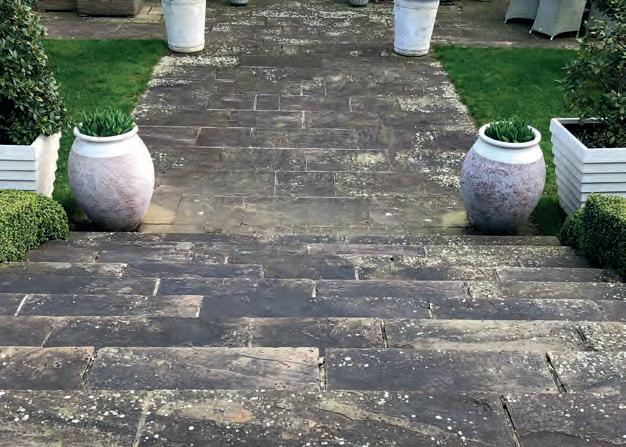

Remover

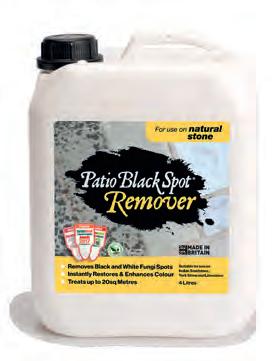

It’s time to roll up your sleeves and get on with jobs to do in the garden in August. Many gardeners will be wanting to extend the flowering season as long as possible after a period of rapid plant growth and make the most of the garden to entertain family and friends. Any garden can start to look a little dusty and dry now, with leaves falling naturally around the borders. It’s best to gather them up to help prevent pests and disease building up. The last official month of summer is also the perfect time to enjoy your garden while it’s still at its best. Children are on school holiday, lawns are in full use, and there’s plenty of delicious fruit and veg to fill your dinner plate. As the traditional month for summer holidays, you may find it difficult to leave the garden for too long but the August garden can look after itself for a couple of weeks. Many
Watering should be at the forefront of your mind this month. Trying, where possible to be sustainable and ecofriendly, supporting the local wildlife. You may find that your water butts are looking a little low as May and June have been very dry. Greywater is a great alternative -relieving pressure on the mains water supplies. With the knowledge that parts of the UK could run dry in as little as 20 years’ time, there’s no time like the present to start conserving water. Greywater is water that has been lightly used. You can use water from paddling pools, baths and showers, sinks, washing machines and other kitchen appliances.
parts of the fruit and vegetable garden will be ready to harvest the fruits of your labour this month. In the flower garden top-heavy bulbs and late flowering perennials need staking and shrubs, perennials and climbing roses that have finished flowering can be cut back. Evergreen hedges looking shaggy after their burst of summer growth should be trimmed back and topiary sculpted to shape. As well as the on-going dead heading, weeding and mulching, it’s also the time to tie in raspberries and replace any straggly lavender bushes. Keep an eye out for pests and diseases like clematis wilt, mildew, ear wigs, ants, scarlet lily beetles and vine weevils, whilst also fending birds off your fruit. Don’t forget to take some time out to enjoy your garden and just spend some time being in it too.
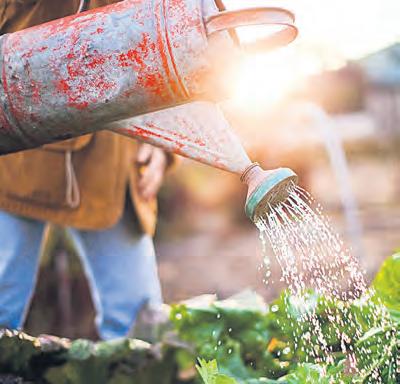

August is the perfect time to start sowing root vegetables and salad leaves like rocket and land cress so you can have tasty treats come winter.
Plant veggies like cabbage, broccoli and Brussel sprouts. Ready for a winter harvest - just in time for Christmas dinner!
Get planting new strawberries as soon as they hit the shelves in the garden centre using soil that hasn’t grown any strawberries in for at least three years.
Don’t limit bulbs to just spring-flowering varieties such as daffodils and tulips. There are bulbs, and also corms (which are very similar to bulbs), that flower in summer and autumn too.
Autumn-flowering bulbs and corms include crocus, colchicum and cyclamen. As they flower in autumn, there are only a few weeks to plant them before they start to flower - so we advise planting as early as possible. They can stand the summer heat and will see your garden through into autumn. These need well-drained soil in a sunny position. As a rough guide, plant each crocus and colchicum bulb three times its own depth measured from top to bottom. Use either a trowel or a special bulb-planting tool.
Cyclamen do not like to be fully buried, so plant them with their tops peeking out of the soil. If you have heavy soil, such as clay, drop a handful of horticultural sand into the bottom of the hole. This improves the drainage to the crucial rooting area.
Feed containerised plants with a liquid fertiliser once a fortnight. There are three ingredients - nitrogen, potassium and phosphorus. Nitrogen helps plants develop strong stems and foliage; potassium supports growth of flowers and fruit; and phosphorus develops the root system.
Fruit and vegetables, as well as flowering perennials, climbers and shrubs, will want a high potassium feed, often sold as tomato food. Most other plants you’ll want to feed at this time of year will favour a multi-purpose feed. In most cases it’s a bit late for a high nitrogen feed as the leafy growth it encourages will be vulnerable in the colder weather in a couple of months’ time.
With heavy blooms and ever-growing stems, plants such as dahlias and gladioli will need staking, if you’ve not done this already. This extra support will not only prevent damage,but discourage ground pests from attacking low-lying plants.
3 7
4 6

Towards the end of the month, take a look at your hedges. If your garden birds have left their nests, you can start pruning and trimming before your hedges stop growing for the year. Provide a place for birds and other wildlife to drink and bathe with a wildlife table or create your own using a spare pot or lid.
Also keep an eye on any birdbaths you have outside. The water can quickly evaporate in warm weather or even start sprouting algae. Clean them out regularly and top them up with fresh water, to help keep your feathered friends cool when the weather heats up.

You’ll need to deadhead regularly to keep your plants flowering into autumn. Fresh blooms not only look good, but continue to feed bees, butterflies and hoverflies, which are essential to a garden’s wellbeing. Sweet peas will be keen to set seed, so it’s important to deadhead them daily, if you can. Just don’t forget to keep up with their watering regime and add a weekly plant feed. While for perennials that have finished flowering, cutting them back will ensure that they remain healthy and that your beds will look tidy.
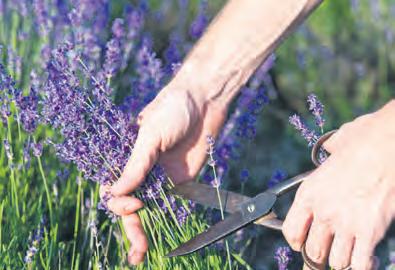
Once flowered, stop lavender from becoming leggy by cutting it into a compact shape. However, you don’t want to cut it too far back, as new flowers can’t grow on old wood. As an added bonus, you can use the cut flowers around the home, by creating lavender pouches to scent your drawers or pillow cases.
The threat of tomato blight reaches a peak over the next few weeks so there’s still time to take counter measures to fight it
The next few weeks can be nervous times for growing tomatoes.
8 10
Now that gooseberries have been harvested, pruning should be carried out to ensure that the plant remains healthy. By creating a ‘goblet’ shape, this will allow as much ventilation as possible to circulate throughout the plant. Start by removing the inner branches of the plant, which will reduce the rest of the plant to about six leaves per branch. Doing this will encourage fresh new shoots to grow.
Cabbage white butterflies will currently be eyeing up your brassicas to lay their eggs, which is why it’s important to check your crops regularly and remove any eggs or pests you find. You can also net your crops and use brassica collars when planting out, to help reduce the chances of pests.
Heat, humidity, and rainfall can cause the onset of blight in potatoes and tomatoes. So, if you see any signs of the fungal infestation, remove the affected plants from the site or burn them to stop it getting out of hand. If you do catch potato blight at an early stage, remove affected foliage but leave the tubers in the ground, as they may be unaffected. And to reduce blight, encourage a crop rotation system, and try to use blight resistant varieties.
11 9
Lawns can look pretty barren at this time of year, especially if there are long periods of intense sun and no rain. With hosepipe bans in place in some areas, it’s best to be as sustainable as possible and put the lawn lower down on your jobs to do in the garden priority list.
Brown lawns at the end of a hot dry summer may look sad, but will always recover in the autumn.

If you do want to have a green lawn, focus on watering in the evening when the ground remains moist for longer. Another valuable tip is to allow longer breaks between cuts, and set the mower blades high – the grass will stay greener for longer, with the added bonus of the nectar-rich flowers of Bellis perennis (lawn daisies) and clover being able to grow. Both are a favourite of many bees.
If you have a wild- flower lawn, don’t be tempted to cut it too early. Let the seeds of your grasses and flowers ripen and disperse before you cut and collect the clippings in early August.

It’s all about the seasonal threat of tomato blight -a fungus-like infection called Phytophthora infestans, that spreads by wind and water splash.
It can be a heart breaker for those who have worked hard to grow perfect tomatoes.
The hope is that this year with long dry periods the blight might not be so bad but the threat is always present.
The crop is quickly ruined, and even if you pick the tomatoes at the first sign of infection, you can’t stop them from rotting.
How to identify tomato blight
Spread by airborne spores that can be carried over 30 miles on the wind, tomato blight is most prevalent when conditions are warm and wet. Outdoor tomatoes are more susceptible to blight than those growing in a greenhouse, mostly because they are exposed to rainfall on their leaves, whereas greenhouse plants can be watered right into the roots. Greenhouse crops are also slightly less likely to be exposed to the airborne spores from other plants nearby.
Keep tomatoes dry and don’t get water on the leaves
Grow tomatoes in a greenhouse or polytunnel if possible, as this will keep the leaves dry and the warmer environment will help fruits ripen sooner than those grown outside.
Use short stakes with bush types to keep their leaves away from the soil.
Take care to water only the soil or compost, keeping the leaves dry.
Provide good ventilation and space between plants
Pick a sunny, sheltered but well-ventilated spot for growing tomatoes outdoors. Leave enough space between plants for air to circulate – don’t be tempted to plant closer than the seed pack recommends.
Perform regular sideshooting on cordontype tomatoes, or they will grow bushy and be more susceptible to blight.
On cordon types, remove lower leaves where fruits have already formed, to increase air circulation, let in light and speed up
ripening. Vigorous bush varieties will tend to produce more leaves than they need, and benefit from drastic pruning to thin the foliage and encourage good ventilation.
Once tomatoes start to flower, use only fertilisers that are high in potassium, such as dedicated tomato feeds. A high-nitrogen fertiliser will boost leaf production, making blight more likely.
Keep greenhouses or polytunnels well ventilated to stop them from becoming too humid and to increase air flow.
Don’t grow tomatoes near potatoes
Don’t plant tomatoes near potato plants, as these are also susceptible to blight and their proximity will make it easier for the blight to spread between crops.
Check plants regularly for blight, from summer onwards, and dispose safely of badly diseased plants.
When the weather conditions are optimum for blight, remember to check your tomatoes and potatoes more frequently.
Employ good hygiene
Once blight hits, remove and destroy the affected foliage to reduce the chances of further infection.
New blight strains in the UK may be able to produce resting spores that remain on plant material through winter and could reinfect next year’s crop. Burn the waste, bury it underground in a deep hole or add the material to your green bin.
Don’t leave potato tubers in the ground at harvest as they, too, could harbour blight.
Try growing early tomatoes
Cherry tomatoes tend to be less likely to catch blight than larger ones, such as beefsteaks, because they ripen more quickly and are often harvested before blight hits.
Choose blight-resistant tomatoes to grow
Some tomatoes have been bred with a degree of blight tolerance – they may still catch the disease,but are able to survive and yield some healthy fruit. Try:
Tomato ‘Losetto’
Tomato ‘Berry’
Tomato ‘Fandango’
Tomato ‘Fantasio’ F1
12
One year’s seeding makes seven years weeding, so the old gardening adage goes, so keep on top of the weeds. So take a ‘weed walk’; taking a turn around the garden with a hoe once a week to keep weeds down.
Dry, warm weather is the best for making sure the weeds sizzle and die in the summer sun. No need to pick them up – just hoe them out and leave them to dry in the sun, thereby returning the nutrients to your garden.

When Ian Blackmore’s wife was confided to a wheelchair after a car accident he was determined to do everything to allow her to keep on gardening and found there were some tricks which would help her.
I have just spent a year researching and learning to live which the fact that my wife who has loved gardening all her life is now disabled.
The car accident left her in a wheelchair. I don’t want to go into detail but enough to say we decided to do everything we could to allow her to garden as normal. I thought my experience might help others
Whether you use a wheelchair, a mobility scooter, a walking frame, a stick or other aid, or are born with conditions that leave you thinking you cannot garden, I suggest you re-think.
Here’s what I have learnt;
A therapist told me pacing your activities is essential, especially if you tire quickly. Set a timer to five minutes. Try working for this period. If you find it is too long, reduce the time.. It is better to do things in shorter periods with gaps in between than working solidly for 30 minutes, after which you will probably be exhausted. Pacing will, over time, result in more work being done because you allow time for rest.
Tools are very personal. Long-handled tools are great for people in wheelchairs and for people who cannot bend or kneel easily, but when buying, try them out.
Tools can be heavy, especially over a period of time. Also, consider looking at children’s tools as they are lighter, robust and normally come in a great range of colours. For some people, raised beds are great. The plants are lifted to a manageable height, and you can even sit on the side of the garden beds while gardening. For some people, whether in a wheelchair or not, twisting the torso is not possible. Consider the use of ‘raised tables’. You can position your wheelchair or mobility scooter underneath or place a chair ready to sit and enjoy sowing, planting and harvesting.
Think about using pots to grow your plants in. Pots can be used for the smallest alpines to large trees. Pots need ongoing maintenance in the form of watering and feeding, but you do not need to worry about your garden maintenance.
If you have difficulty bending or can only reach a certain height, consider growing plantsup a wall. There are some excellent vertical planting systems on the market. Ensure they are fitted securely to a wall or fence and have a drip irrigation system. A cheaper alternative, which will need replacing every year, is to use a hanging show organiser.
When sowing seeds in borders, veggie patches, or allotments, use plastic tubing. Clear tubing is best, but standard water tubing is fine. Cut to the right comfortable length, either from a seated position in a wheelchair or a standing position without bending. After making planting holes in the soil, position the tube above the hole and drop a seed into the top of the tube. Let gravity do its thing, and with minimal effort, a seed is planted in the hole.
When thinking about a garden for someone with a disability surface material is important. The thing to remember is to have a level, firm, stable base with a top material that does not give off too much glare, gives just the right amount of resistance whether on foot or using a wheelchair, is flat and, where possible, has a raised edge so that it stops wheels, or, for more ambulant individuals, makes you aware of the edge of the path.

Staking and supporting plants in borders is a key gardening practice which guarantees the health and visual appeal of plants. Borders, often densely planted for maximum colour and texture, can become chaotic or even damaging to individual plants without adequate support. By staking or supporting plants properly, gardeners maintain structure, encourage growth, and protect their investments in plants and time.
One of the most important reasons for staking is plant health and stability. Many herbaceous perennials and tall flowering plants, such as delphiniums, peonies, or hollyhocks, have heavy flower heads that can cause stems to bend or break under their own weight. Wind, rain, and the general jostling from neighbouring plants can exacerbate this issue. Staking helps keep stems upright, preventing breakage and disease that can enter through damaged tissue.
Aesthetic value is another critical aspect. A well-supported plant stands upright, allowing its form and flowers to be showcased to full effect. Without support, a sprawling or collapsed plant can spoil the design of a border, making it appear unkempt. Borders are often planned with height gradation and layering in mind when plants fall over, they disrupt the visual flow and can obscure smaller or more delicate companions.
Supporting plants also encourages better air circulation and light exposure, reducing the risk of fungal diseases such as powdery mildew or botrytis. Airflow between stems and leaves is crucial in tightly planted borders, where moisture can easily become trapped. By lifting plants off the ground and spacing them properly with supports, gardeners promote a healthier growing environment.
Additionally, staking and support systems provide a level of garden longevity and maintenance ease. Upright plants are easier to deadhead, prune, or harvest, and they’re less likely to smother neighbouring species. In mixed borders, where perennials mingle with shrubs and annuals, clear structure helps prevent competition for light and space.
Choosing the right type of support is equally important options range from discreet metal rings and grids to natural materials like bamboo canes and hazel twigs or study formal concrete posts and wire supports . The goal is to provide structure while blending with the overall aesthetic of the garden.
Staking and supporting plants in borders is not merely decorative but an essential practice for plant vitality, garden design integrity, and ease of care. It is a small, often overlooked task that significantly enhances the performance and appearance of a wellplanned garden.
You can control your shrubs and climbers this year using Rivelin Glen Products uniquely designed Wire Anchors. They are quick and easy to attach to concrete posts (without drilling) to act as an ‘eye’ by threading wire through them to create a trellising system.

The Gripple Trellising System is ideal to use with the anchors as the wire does not stretch, takes up to 100kg load & has
Multiple rows can be achieved with one length of wire and two tensioners. No more sore hands or sagging wires!
Rivelin Glen Products are the main stockists of the Gripple Trellising System. Prices: Wire Anchors from £10.25 for a pack of three; Gripple Starter Kit - £20.25 Details available at: www.rivelinglenproducts.com Email: info@rivelinglenproducts.co.uk Tel: 01246 462666




most concrete posts FREE UK DELIVERY Main Stockists of Gripple Trellising Visit our website to view our other gardening accessories and gift ideas www.rivelinglenproducts.co.uk info@rivelinglenproducts.co.uk 01246 462666




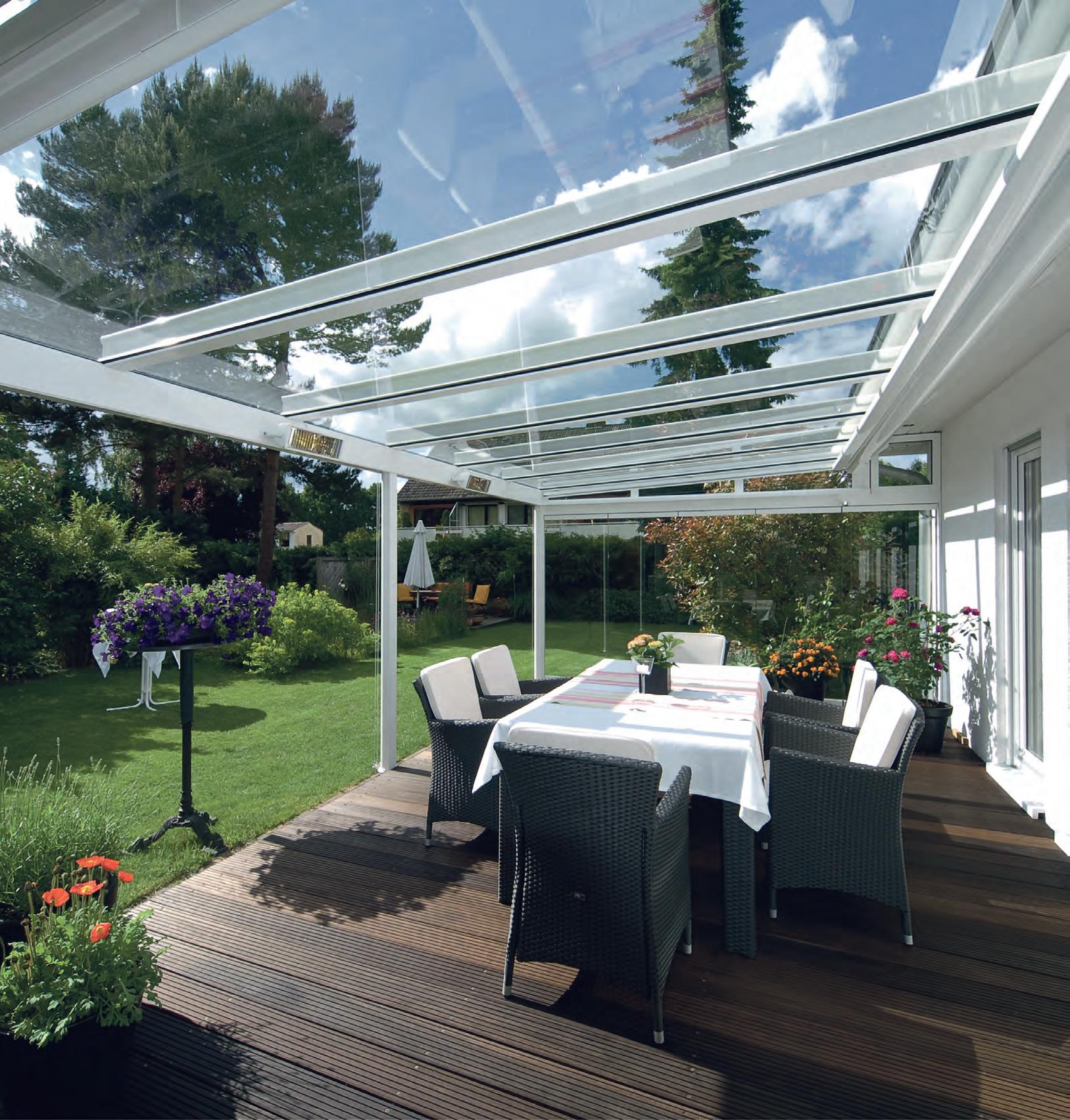






















Vertical gardening can be affordable, easy to set up, and it expands home garden space while making gardening so much easier. And who doesn’t want a better system of gardening?
It’s obvious really. Anyone looking for a better system of gardening must consider growing things upwards.
Vertical gardening is an efficient way to add more plants to your garden, especially in a tiered garden. Every garden has some vertical space that can be transformed – it could be a fence, a wall or even a windowsill. You can also create vertical planting areas with a tiered stand or plant ladder.
Obelisks, wigwams and pergolas can be planted with climbers, fences covered with roses and clematis, or crevices in walls packed with succulents. To keep costs down, try repurposing tin cans or plastic bottles, turning them into planters for a colourful display on your fence.
Green walls are another way to use fences, and they can hold a wide variety of flowering plants. One drawback is that they can be high maintenance, especially if you can’t connect an irrigation system to the mains.
If you don’t have room to grow your own, try creating a vertical herb garden for easy pickings or growing climbing veg. There are many exciting ways to enhance walls and fences.
Vertical gardening is basically growing plants upwards instead of allowing them to ramble around on the ground.
Harvesting plants is much less work when the fruits and vegetables are hanging down within reach; no kneeling and no digging through the leaves on the ground to find the fruits.
While there are a lot of different vertical gardening systems out there, all of them reduce the footprint of the plants and expand the number of plants that can be grown in a particularly small space.
Fruits, vegetables, and fresh herbs grown vertically are usually healthier and highly productive too.
The benefits of growing vertically are many. The first reason is space. For instance, the footprint of a pumpkin plant growing on the ground is about 20 square feet.
However, by growing it up and over an arched trellis, the footprint is reduced to just a few square feet. It can share a raised garden bed with many other plants because most of the growth goes up and over a walkway.
Picking vegetables when you’re standing upright saves your back and knees. Plus, when the food is up and right in front of you, you’re less likely to miss it when you’re harvesting.
HEALTHIER
Vertical gardening even improves the health of your plants. When plants are trained up a trellis, they aren’t lying in the dirt where they can get splashback from rain and watering which keeps the leaves moist.
Moist and dirty foliage is a recipe for bacterial and fungal infections, blight, and wilt. When your fruit is up off the ground, it is out of the reach of little creatures that would like to come along and eat it before you get a chance to.
GROWING SOMETHING BEAUTIFUL
Finally, vertical gardening is stunningly beautiful. It adds line and structure to the design of your garden while being completely functional.
It puts your food on display and makes for spaces that are interesting and engaging. Arched trellises can create truly magical gardening spaces that you will want to spend time in.
If you do a quick search online for vertical gardening, you will come up with a lot of ideas like hanging baskets, pots suspended on empty wall space, or gutters arranged in a stair-step structure. However, if you have vertical gardening in mind for food production, cute little pots aren’t what you need.
KEEPING COSTS DOWN
The goal should be to make it as functional and productive as possible while keeping the price point as low as possible and then, within that, making it aesthetically pleasing.
If vertical gardening affordably is your goal, be resourceful! Consider other items that work well for creating a vertical trellis but aren’t necessarily marketed specifically for that purpose.
Vertical gardening is a way to maximise a small garden space or underused feature such as a wall, fence, or other gardening structure.
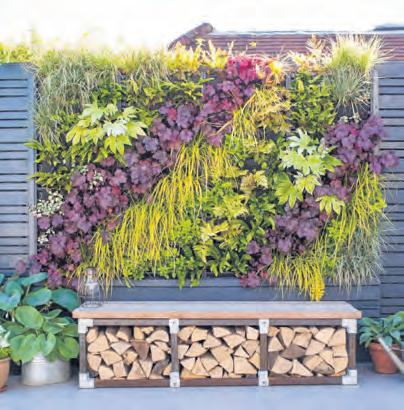

To utilise vertical outdoor space, plants can be grown up a trellis, arbour, or other structure, or allowed to trail out of a hanging basket or planter box. Displaying containers or pocket pouches on a fence or wall is another way to get more out of your growing space. Here are some basics considerations for vertical gardening, along with ideas for inspiration. A vertical garden can be used to create privacy, establish boundaries, block out an unsightly view, or to cover an ugly wall or fence.
ARBOUR, TRELLIS, OR PERGOLA: Use one or more of these structures to train perennial climbing roses, wisteria, clematis, or honeysuckle. Fast growing annual vines can be used as a quick screen.
HANGING BASKETS, PLANTER BOXES, AND CONTAINERS: Plants can be grown in hanging planters or baskets on a porch, patio, deck, or balcony. Display planter boxes on a home, garden shed, or fence. Pots can be affixed to a fence, displayed on a shelf, or suspended in plant hangers.
FENCE: Attach shelving, pouches, or other containers to a fence to grow small perennials, annuals, herbs, strawberries, and other edibles.
WALL: Any type of wall can be used to train vining plants. Some plants such as ivy can attach themselves to walls with aerial roots. Trees and shrubs can be espaliered, while other plants will need a trellis for support.
LIVING WALLS: More typically used in public or corporate settings, a permanent wall garden can also be used in a residential landscape. These vertical structures utilise a growth medium of soil, substrate, or hydroponics, and usually include built-in irrigation systems. Climbing or cascading plants are trained to cover the wall space for a lush display of vegetation.

MAKE IT SECURE: Make sure walls, fencing, vertical planters, or other structures are sturdy enough to support the weight of containers and plants. Fix planting containers securely so they don’t become detached or fall.
SUPPORT, SUPPORT AND MORE SUPPORT: Larger perennial vines such as wisteria and trumpet vine need a sturdy arbour or pergola to support the weight and vigorous growth. Smaller vines such as most clematis or annuals can be grown on smaller trellises.
SOIL: Provide the right growing conditions for plants such as climbing roses or wisteria vine that are planted in the ground. For containers, use a high quality allpurpose potting soil. Some living wall systems are hydroponic, using no soil.
WATER: Plants in the ground can be watered according to individual needs. Make sure containers have adequate drainage holes to prevent root rot. Potted plants dry out more quickly and will need more frequent watering or misting.
PRUNING AND MAINTENANCE: perennial vines such as wisteria and trumpet vine need proper and regular pruning. Make sure this is something you have the time and expertise to do.
If you have any gardening queries you would like help with then email us at editorial@countrygardener.co.uk
I love lilies and fuchsias equally and they are both my passion when it comes to the garden. Can I plant them together and what do they like to live with, and where am I best to plant them?
Donna Starmer Liss
To grow lilies and fuchsias together you need to split them into different parts of the garden. They have different needs. Place lilies in the sunnier parts of the border or toward the front where they can get good light. Grow fuchsias in partial shade or behind the lilies where they can enjoy cooler roots and protection from strong sun. Use mulch to keep soil moist and cool for both.
I have a tree peony which I bought at a garden festival three years ago and it looked a very healthy bargain. It has been disappointing and does not seem to progress at all. It is now a small pathetic looking plant and has never flowered. After three years should I give up on it?
Jack Williams Exmouth
It might be worth being a little more patient. Tree peony’s are notorious for being slow to flower. They really need to be well established before they start to produce blooms and this can certainly take three years or more. It’s also worth checking that they are growing in suitable conditions and making improvements where necessary. For instance, it might need moving to a sunnier spot.
Tree peonies are at their best in sunny positions and won’t do well in shade. They also need shelter from cold drying winds. You also need to check the soil isn’t too wet as the plant will struggle and eventually rot.
Tree peonies like moist soil, but it must be well drained.
Feed your peony with a high potash feed during the growing season as they are heavy feeders. The potash will encourage flower production.
I was wondering if there was any advice about what I should do with my boxwood hedge (the one on the end in this photograph) and how to have the next one not die. The first one lasted six years and the next two have died within a year. Does this mean any disease will spread and I should get rid of the whole thing or can I try and keep some of it alive. Also, can I take cuttings from the now healthy plant?
Andie Howarth Cheltenham
This looks like a straight forward case of box blight which once it gets hold of a plant is fatal. With the two sections close together you would have to be very lucky for the blight not to spread but it is worth waiting. With the diseased section dig it up and burn it and clear out the soil well. Yes, if the healthy section survives and thrives you can take cuttings but box blight is a difficult disease to come to terms with.
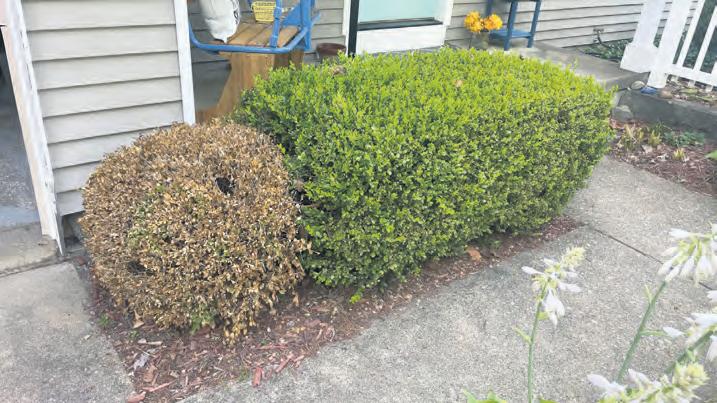
I have a mature crab apple in the garden which has developed white woolly deposits on its branches. Is this a fungal disease or a pest and it looks awful, how do I get rid of it?
Pauline Moore Plymouth
This is almost certainly woolly aphid disease. Woolly aphid is common on edible and ornamental apple trees, pyracantha and Cotoneaster horizontalis. The insects produce a white waxy ‘fluff’ that can be mistaken for fungal growth. If you can tolerate populations of aphids, aphids often do not affect cropping or future health of the tree.
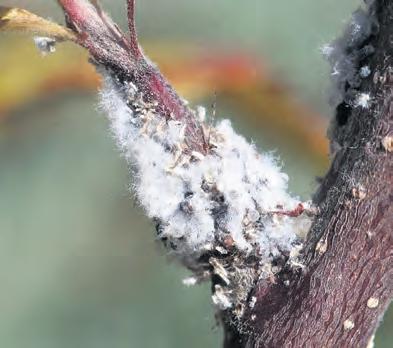
Use finger and thumb to squash aphid colonies where practical by hand. Encourage aphid predators in the garden, such as ladybirds hoverflies, parasitoid wasps and earwigs. Be aware that in spring aphid populations often build up before natural enemies are active in sufficient numbers and then later in the season should solve the problem.

For the second year in a row our lawn has been badly affected by fairy rings which are spreading out in ever increasing circles and are very unsightly. What can I do to get rid of them?
Chrissie Davies Martock
Fairy rings are caused by a fungus which grows within the roots of the grass. The fungus causes characteristic circles of toadstools in autumn but are visible throughout the year as circular areas where the grass dies back. The spores are airborne so there is little that you can do to stop a colony forming in the first instance. Once a colony forms it begins to spread gradually outwards, dying back from the centre and so takes on a ring like appearance. Fairy rings are not particularly harmful.
In terms of control there is little that you can do. There are no chemical controls available. Given that the mycelium grows outwards through the soil then in minor instances you could dig out that area of soil (from beyond the outside of the ring, and to a depth of around 30cm) and replace it with fresh topsoil and turf. However, if you have lots of rings then this would be very expensive and make a horrible mess of your lawn. Being realistic, you may have to learn to live with them.
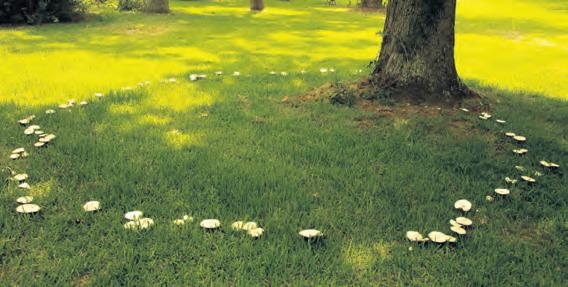
I have become passionate about composting in recent years but in May I emptied a large compost bin which had top soil - however I did not find any worms. Does this mean the soil is unhealthy and I haven’t been doing it correctly?
Olga Pederson Taunton
Worms will only be present in soil if there is a supply of organic matter for them to eat, such as dead leaves, decaying plant material or manure. If your compost bin is sitting on the ground with easy access for worms or whether it is raised up on feet then soil in the compost bin could have lacked organic matter or it may have become too saturated with water or too dry for worms to be happy. Also, if it has been in there for a while there could be a lack of oxygen in the soil. Once the topsoil is spread back out in the open many creatures should start to inhabit it again. You can help improve your soil by digging in lots of organic matter such as well rotted manure or compost.
We are moving into a new house and there is a 20 metre hedge which forms part of the boundary with our neighbour. It is a straggly hedge which seems to be growing at stages both on our land and the neighbours. We didn’t raise it as part of the conveyancing so what is the law and should I be worried?
Ian Stevenson Exmouth
Boundary hedges can spark a lot of disputes, especially when it comes to their height and upkeep.
The general consensus is that if the main stem of a hedge is on your land, it’s your property, and if part of that hedge encroaches onto your neighbour’s land, they’re within their rights to trim it back. However, it can get a bit more complicated. In the UK, the Anti-social Behaviour Act 2003 helps manage any issues that arise from high hedges, like when they obstruct light or entry. This law defines a high hedge as a line of two or more evergreen or semi-evergreen trees or shrubs over two meters tall that block light or access.
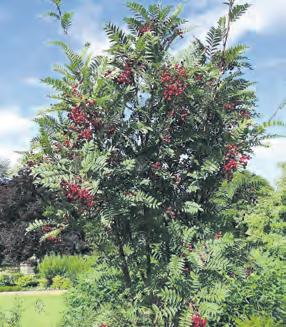

Can you recommend a small, upright growing ornamental tree for our front garden? We don’t want it to have too wide a canopy that casts too much shade. It will be in a south facing garden.
Sorbus vilmorinii (Vilmorins Rowan)is a wonderful tree which fits your question. It has delicate ferny foliage, panicles of creamy white flowers followed by pink-red berries and astonishingly good autumn colour. Better still, it has a small canopy and an open habit.
You might also consider one of the smaller crab apples crab apples can be quite messy when they drop their fruits, so these are not great for paved areas! Amelanchier ‘Ballerina’ is another good small tree for a long season of interest with pretty spring flower and lovely coloured foliage. Acer psuedoplatanus ‘Brilliantissimum’ is a good choice too and has lovely autumn colour, or you might like Acergriseum for its beautiful peeling bark.
Why is my gardenia not flowering? It seems a lovely healthy plant but no flowers. Michaela Davies Dorchester
There are two issues. Firstly, it might not be in the right spot so ensure that it is planted in a spot where it gets full sun to light shade. Then it might be a feeding problem so make sure that your gardenias has enough of the right nutrients to flower - feed it with an acid loving plant fertiliser to promote new growth and an abundance of blooms.
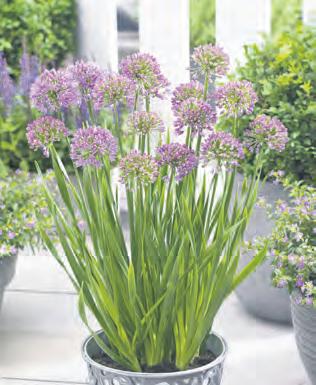
We’re planning a redesign over the autumn/ and getting rid of our lawn to create large new flower beds, so I want to get ahead of next year’s need for plants with things that will be ready for the spring.
I’ve bought a load of allium bulbs so I can put them in individual pots over winter in the greenhouse then plant them into the new borders in spring, however I’ve read starting bulbs in pots means you should really leave them in the pots for their full growing season. Is that true and if I ignore that advice and plant them out in the spring before they flower will I harm them in the long run?
Kathy Grey Exeter
The advice you have read is correct. If you plant a bulb in a pot, you should avoid transplanting it until it’s finished flowering, or you will stunt or potentially kill the bulb with exhaustion. So, plant the bulbs in pots now but wait until next June to get them in the ground. Planting out in March next year will only cause the alliums to have a massive mood swing. They are quite fussy in terms of stability and consistency. When a bulb is in flower, it’s at the peak of its energy use. It’s sending stored resources into producing the flower and is not yet replenishing those reserves. Digging it up or moving it at this stage will cause the bulb stress, leading to poor flowering the following year or even bulb death.


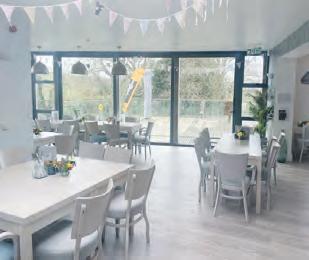

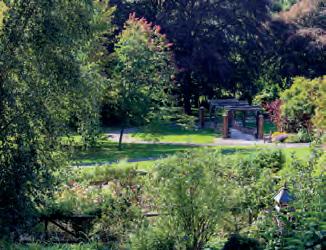
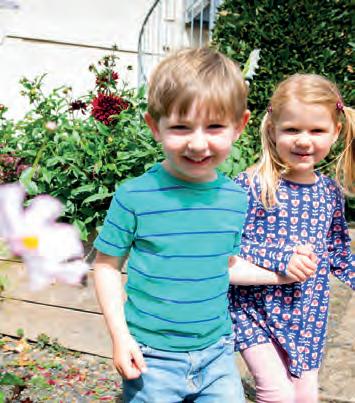

compiled by Vivienne Lewis


For this holiday month we’re venturing further, towards Herefordshire and Wales, and down to Cornwall, as well as the usual areas covered by Country Gardener, so if you’re travelling around why not visit a lovely garden that’s opening for nursing and caring charities under the National Garden Scheme? We advise checking before starting off whenever possible as circumstances can force cancellations occasionally. www.ngs.org.uk
Calmsden, Cirencester, Gloucestershire, GL7 5ET
With borders originally designed by Mary Keen, Calmsden Manor is a well loved garden opening for the NGS on Bank Holiday Monday 25th August from 2.30pm until 5.30pm. A treat for plant lovers, design enthusiasts, vegetable growers, with herbaceous borders, a small arboretum, wild grass and flower meadow, and a walled garden. Admission £10, children free.

Nash Lane, Marnhull, Sturminster Newton, Dorset DT10 1JZ
Opening for the National Garden Scheme on Saturday 23rd and Sunday 24th August from 1pm5.30pm each day, the garden has been eight years in the making, a plantsman’s garden with deep perennial borders, large netted vegetable area, water harvesting, and all work in progress. A riot of colour with salvias, grasses and hot plants in late summer, all plants for pollination and year-round interest. Admission
76 Gretton Road, Winchcombe, Cheltenham, Gloucestershire, GL54 5EL
Visiting this garden, opening for the National Garden Scheme on Sunday 24th August from 11am until 4pm, is like stepping into another world - huge leaves, tall exotic plants jostling for light with the small and the delicate. Created with a passion for the exotic landscapes of the Caribbean which was inspired by a visit to Barbados. Admission £4, children free.

Elworthy, Taunton, Somerset TA4 3PX
A regular opening for the NGS, this time on Tuesday 5th and Bank Holiday Monday 25th August, from 11am until 4.30pm, a one-acre plantsman’s garden in a tranquil setting, with island beds, scented plants, unusual perennials and ornamental trees and shrubs planted to encourage birds, bees and butterflies, wildflower areas and a developing wildflower meadow, a decorative vegetable garden, living willow screen and seats to enjoy views of the surrounding countryside. The plantsman’s nursery is open at the same time. Admission £5, children free.



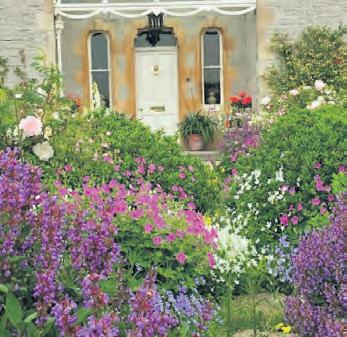
Swanage, 25 Newton Road, Swanage, Dorset BH19 2EA
Opening for the NGS on Wednesdays 6th/13th/ 20th and 27th August, 2pm-5pm each open day, a dramatic sunken former stone quarry, a surprising garden at the top of a hill above the seaside town of Swanage. Stone terraces with many unusual shrubs and grasses form beautiful patterns of colour and foliage attracting butterflies and bees. Pieces of medieval London Bridge lurk in the walls. Steps have elegant handrails. WC available. Admission £4, children free.
West Bradley, Somerset BA6 8LS
Opening for the NGS on Saturday 23rd August from 11am until 5pm, the layout and planting began in 2003, by a garden designer and a painter. The four acres have three distinct gardens around the house with exuberant mixed herbaceous planting and shrub borders leading to a meadow and orchard with wildflowers. Admission £6, children free.
Manaccan, Helston, Cornwall TR12 6HU
Opening for the NGS on Wednesdays throughout August and September, 10.30am5pm each day, a delightful garden near Frenchmans Creek, on the Lizard, which is the setting for Kestle Barton Gallery; wildflower meadow, Cornish orchard with named varieties and a formal garden with prairie planting in blocks by James Alexander Sinclair. A riot of colour in summer. Admission by donation.

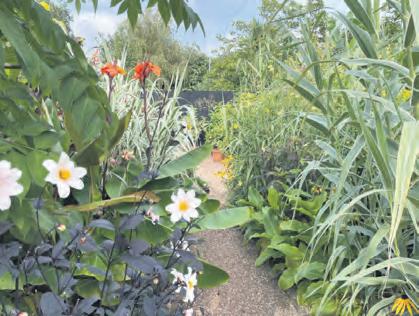
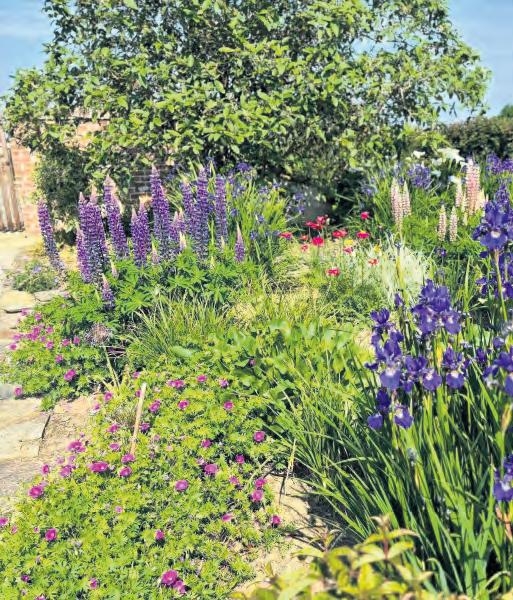
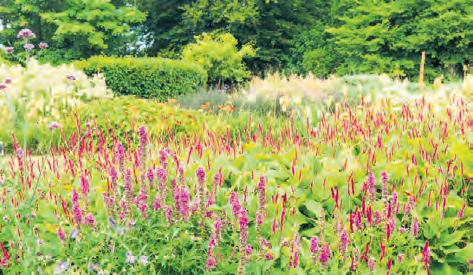
31 Anne Crescent, Little Elche, Barnstaple, Devon EX31 3AF
Explore two amazing spaces opening for the NGS on Sunday 17th August from 11am until 4pm. 31 Anne Crescent is a small urban L-shaped tropical garden complete with wide variety of large palms, agaves, bananas, cacti, tree ferns and delightful pond surrounded by large tree ferns. 32 Allenstyle Drive has a 30 x 15 metre garden packed with huge bananas, cannas, colocasias, delicate and scented tropical passionflowers, rudbeckias, perennial sunflowers, a wildlife pond, a new large cedar greenhouse, and many seating areas. Dogs allowed at 31 Anne Crescent.
Alverdiscott Rd, Bideford, Devon EX39 4PN
Opening for the NGS on Saturday 9th and Sunday 10th August from 2pm until 5pm, a two-acre country garden managed by head gardener, Fiona Thompson, with striking herbaceous borders, dry stone terracing, white garden, Japanese themed garden, and “hot” garden. Extensive Soil Association certified organic vegetable gardens with polytunnels and greenhouse and walled garden. Orchard with traditional apple, pear and plum trees. New woodland meadow area and herb garden. Admission £5, children free.
Farmyard Farm, Dol Llan Road, Llandysul, Ceredigion SA44 4RL
Opening for the NGS on Sunday 24th August from 10am until 4pm, a large, serene woodland garden with extensive plantings to complement the existing natural trees and shrubs. Numerous paths lead to a small lake with many ducks, the ‘hobbit house’ and adjoining large stumpery, and the acer grove.
Admission £5, children free.

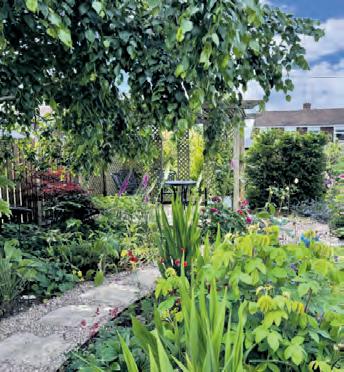
Purton, Swindon, Wiltshire SN5 4EU
Set in the picturesque village of Purton, this small cottage-style garden opening for the NGS on Saturday 9th and Sunday 10th August from 10am-4pm each day, is a hidden gem packed with roses and planted for wildlife. Divided into different areas, with shaded pergola, sunny lawn and wildlife pond. Limited parking. Admission £5, children free.


Donhead St Mary, Shaftesbury, Dorset SP7 9BZ
Opening for the NGS on Sunday 24th August from 2pm until 5pm, a small, long garden in two parts laid out beside an Iron Age hill fort with spectacular views. A formal area with colourful planting and pots is followed by a paved area with steps leading through to a more informal garden. Topiary, roses and clematis on tripods. Admission £5, children free.
Bourtonon-the-Hill, Gloucestershire GL56 9AE
One of the the finest gardens in the Cotswolds, the awardwinning, three-acre garden opens for the NGS on Sunday 17th August from 10am until 5pm, featuring imaginative topiary, wide herbaceous borders with many rare, unusual and exotic plants, in stunning plant, texture and colour combinations, a unique shade house and many creatively planted pots. The White Garden and an 18th century raised walk have views over the rolling Cotswold countryside. Several spring-fed water features include a raised basket pond from the Great Exhibition of 1851. Admission £10, children free.





Are you struggling to manage at home but want to stay surrounded by the comfort of your own garden?
Our live-in care lets you remain safely at home with support tailored to your needs; no level of help is too big or small. Whether you want help with daily tasks or just companionship to enjoy your garden and home, our experienced carers respect your independence and privacy every step of the way.
As a national family-owned care provider, we combine national expertise with a personal, local touch.
Call today for a free, no-obligation consultation to discuss your needs and wishes.

We offer
Flexible or 24 hour care
Immediate availability
No obligation trial period
No long-term contracts
A carefully matched carer
Rated ‘Excellent’ on Trust Pilot

Our popular gardening themed crossword is compiled by Saranda which over the past year has become enormously popular with readers. The winning entry to be drawn by us will receive £100 of RHS gift tokens. Completed entries should be sent to Mount House, Halse, Taunton, Somerset TA4 3AD. Closing date Friday 29th August. The June issue winner was Georgie Smith.
Twelve questions to test your knowledge
1. What flower is named after the botanist Dr Leonard Fuchs?
2. Harry Wheatcroft was a renowned breeder of what?
3. What is the popular name for the flowering houseplant Impatiens walleriana?
4. What fruit was cultivated by crossing a blackberry with a raspberry?
5. What are frankincense and myrrh made from?
6. What country do amaryllis bulbs originate from?
7. What is antirrhinum commonly known as, due to the flower’s resemblance to a mythical creature?
8. What colour is a Welsh poppy?
9. Which garden plant in the 17th century was exchanged as a form of currency?
10. On which continent did broccoli originate?
11. What vitamin is most prevalent in a lime?

BADGER BANK VOLE BARN OWL
FALLOW DEER FIELD VOLE
SQUIRREL
SQUIRREL DORMOUSE
12. Often called England's greatest gardener, what is Capability Brown's given first name? QUIZZING DOZEN:tree resin from boswellian and 1. Fuschia, 2.Roses, 3.Busy lizzie, 4. Loganberry, 5. Dried Tulips, 10. Europe, 11. Vitamin, C 12. Lancelotcommiphora, 6. South Africa, 7. Snapdragon, 8.Yellow, 9.
MARTEN
ACROSS
1. The existence of a plant in two or more distinct forms during its life cycle (10)
6. A dry fruit that splits into single-seeded parts when ripe (10)
13. To surpass another in boasting (7)
14. Sculptures that stand out from the surrounding background (7)
15. Heather genus (5)
16. A mystical summer flowering plant, Circaea lutetiana (10, 10)
17. What is left after cutting grass? (7)
19. An angiospermous plant having an embryo with a single cotyledon (7)
21. The small drupes that create the fruit of berries (5)
22. Sweet and juicy, and served at Wimbledon! (10, 10)
26. Certainly (archaic) (4)
27. Deborah starred in the Black Narcissus (4)
28. Old English word for the ash tree (4)
30. An exclamation of Bacchic frenzy (4)
34. He works on the land? (12, 8)
37. A shallow oval dish or large plate (5)
39. An Italian child (7)
41. Having flower heads that bend downwards (7)
42. Hedgerow bubbly? (11, 9)
46. A tropical African tree with wood like teak (5)
47. A critically endangered salamander (7)
48. He followed the teachings of John Wycliffe (7)
49. Common wild flowers of the Veronica genus (10)
50. A very old, red-skinned English apple (4, 2, 4)
DOWN
1. Sterculia foetida or bastard ____ tree (4)
2. First name of 'Goodbye England's Rose' composer (5)
3. Genus of liverworts named after a French botanist (10)
4. 410-acre green space in London designed by John Nash (7, 4)
5. Barley belongs to this genus (7)
7. Dear or darling in French (5)
8. Hearty meal made with mutton, potatoes, carrots and onions (5, 4)
9. Made more dark or gloomy (10)
10. The madder plant of the Middle East (7)
11. Genus of plants including scorpionweed (8)
12. Richness or luxury (9)
17. A plant of the genus Xanthosoma, yielding edible tubers (6)
18. Drooping like a plant or flower (7)
20. A sculptured basket of flowers as an architectural decoration (7)
23. An error in printing or writing (7)
24. A board game for two players invented in 1883 (7)
25. A Scottish term for a grassy ridge or piece of unploughed land (3, 3)
29. Genus of the Japanese quince (11)
31. Alternative name for Quassia amara or hombre grande (10)
32. A perfumery ingredient derived from the rhizomes of certain iris species (5, 4)
33. He wrote Blue Jasmine and the Purple Rose of Cairo (5, 5)
35. Botanically, something arranged in a flower cluster where pedicels radiate from a single point (9)
36. Pentland potatoes (8)
38. The portion of the plant tissue that conducts water (7)
40. Ligularia dentata cultivar, leopard plant or this? (7)
43. A circular arrangement of leaves or flowers around a stem (5)
44. An organisation that runs canteens for British service personnel (5)
45. Provide a border in a garden (4)
ACCOMMODATION
Secluded cosy cabins & lodges in wooded valley running down to Wembury Bay & SW Coastal Path

Plymouth, Dartmoor & lovely South Devon
& Towns in easy reach. Pets Welcome. Forest School. Tel: 01752 862382 www.churchwoodvalley.com

Carmarthen Bay South Wales Seafront chalet situated on estuary. Sleeps up to 6. Seaview. Well Behaved Dogs Welcome Free of Charge. Free WIFI. Open from 1st March - 31st Dec. For Brochure Tel: 01269 862191
BOSWORLAS, ST JUST. Cosy Cottage sleeps 2-4. Please email info@bosworlas.co.uk for availability
GLORIOUS NORTH DEVON. Only 9 cosy caravans on peaceful farm. Wonderful walks in woods & meadows. Easy reach sea, moors & lovely days out. £125-395pw. Discount couples. Nice pets welcome. 01769 540366 www.snapdown.co.uk
ACCOMMODATION HOLIDAY COTTAGES
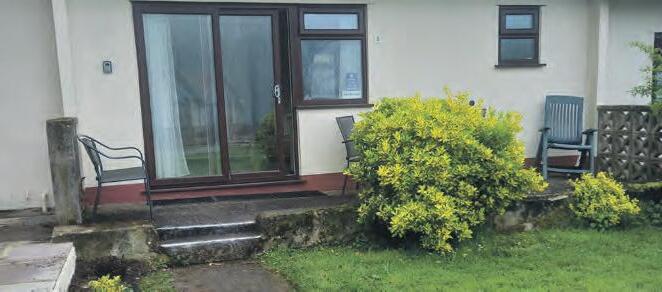
A quiet holiday bungalow near Sidmouth, overlooking the Donkey Sanctuary. Ideal for walkers and nature lovers. Sleeps 4. Bookings from April to the end of October.
jandtmercer@gmail.com

01769520266 www.horrymill.co.uk Email: horrymill@aol.com
RYDE COTTAGES, ISLE OF WIGHT. Sleep 2 and 4. Close to beach and town. 02380849565. rydecottage@talktalk.net www.rydecottage.co.uk

Peace, Privacy and Stunning views.
4* Delightful cosy cabin for 2 nestling between Wye and Usk Valleys. Shirenewton village & pubs close by. Comfy bed and splendid views, walks, castles and bustling market towns. Perfect for all seasons!
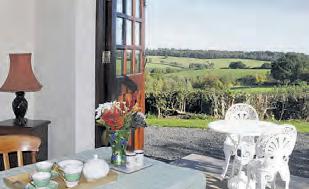
Tel: 01291 641826
Email: lynne@bryncosyn.co.uk www.bryncosyn.co.uk
WYE VALLEY/FOREST OF DEAN. Fully equipped single-storey cottage with two en-suite bedrooms. Wi-fi.Recently awarded Visit England 4-star GOLD. Rural retreat, shops/pubs one mile. Enquiries welcome. AS SEEN ON ESCAPE TO THE COUNTRY! Tel: 01594 833259 www.cowshedcottage.co.uk
ACCOMMODATION WITH BEAUTIFUL GARDENS

NORTH DEVON NEAR CLOVELLY. 3 delightful cottages situated in 12 acres of idyllic countryside. Sleeps 2-4. 1 Wheelchair friendly. Brochure: 01237 431324 www.foxwoodlodge.co.uk foxwoodlodge@outlook.com
BED & BREAKFAST

Gloucestershire Quality Bungalow B&B
Ensuites, rural, large garden, paddocks, sheep and fruit. Ideal Cotswolds, Malvern’s, Forest of Dean, cycle storage, ample parking, Wi-Fi £44 p.p.p.n. Tel: 01452 840224 sheila.barnfield1960@gmail.com

A range of over 200 greetings cards and prints from the flower paintings of ANNE COTTERILL We sell to both individuals and trade. No order too small. Contact us for your free catalogue.
Mill House Fine Art Publishing, Bellflower Gallery,


TOOL SHARPENING. WHILE-U-WAIT. Gardening and domestic tools sharpened by a 55yrs experienced tool sharpener. Very competitive prices. I call at various garden centres, Willowbrook, Sweetacre, Cadburys, Whitehall, Mintys, Barters and Trowbridge. For more information call frank on 07562717620 or email franksynekartisan@gmail.com
GARDEN SERVICES


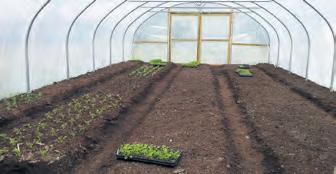



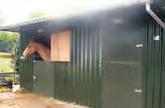
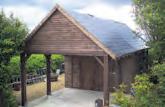
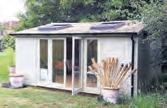


Welcome to our August Time Off and details of gardening club and association events and meetings over the next few weeks. This is a free service in Country Gardener and if you would like to take advantage of it and give events some publicity and promotion then email us at editorial@countrygardener.co.uk
August
5TH
Marldon Gardening Club
‘FLORAL ART AND THE SUMMER SHOW’ - TRACY JOHNSON 6TH
Brixham Horticultural Society MONTHLY MEETING
Details on 01803 842121
Goodleigh Horticultural Society PRE-SHOW MEETING 7TH
Teignmouth Gardening Club
‘THINKING OUTSIDE MY URBAN BOX’ - KENNY RAYBOULD email:nickcooling4@aol.com 9TH
Goodleigh Horticultural Society ANNUAL SHOW 16TH
Exminster Gardening Club ANNUAL SHOW Details on 07749 726497
Plympton Gardeners Association SUMMER SHOW




August is far from the end of the gardening season. With some thoughtful planning, it can mark the beginning of a colourful autumn harvest. Whether you’re growing vegetables, herbs, or flowers, it’s a month which gives opportunities to keep gardens thriving.
Cool-season vegetables
August is a great time to plant cool-season crops that will mature as temperatures drop. These vegetables often taste better after a light frost, making them excellent for late-summer sowing.
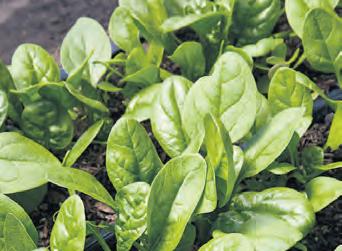
1. Leafy greens:
Fast-growing greens like lettuce, spinach and Swiss chard are excellent choices. These crops germinate quickly in warm soil and can be harvested in as little as 30 days. Consider planting them in partial shade if temperatures are still high.

2. Brassicas:
Vegetables in the cabbage family, such as broccoli, cauliflower, cabbage, and kale, can be planted in early August for an autumn harvest. Sow seeds directly into well-prepared beds. These crops benefit from maturing in cooler weather, which enhances their flavour and reduces pest pressure.
3. Root Vegetables:
Carrots, beets, turnips, and radishes can all be sown in August. These do well as days shorten and temperatures moderate. Radishes, in particular, grow very quickly and can be ready to harvest in three to four weeks.
4. Peas:
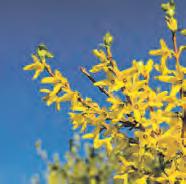



August can be a great time to sow an autumn crop of sugar snap or snow peas. They appreciate the cooler temperatures of early autumn and can be surprisingly productive before the first frost.
Herbs
Many culinary herbs do well when planted in August. While some are annuals and others perennials, late summer is still a good time to get them growing.
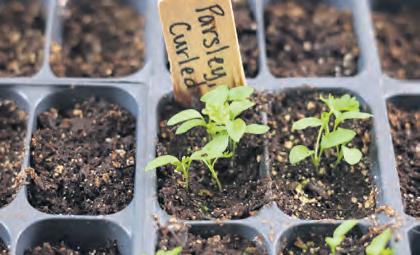
1. Parsley:
This will thrive in cooler temperatures and tend to bolt quickly in summer. Planting them in August means you’ll get a strong crop in the autumn
2. Dill:
Dill matures quickly and can be grown for both its leaves and seeds. Late summer plantings can provide a harvest in time for autumn pickling or seasoning.
3. Chives and thyme:
These hardy perennial herbs can be planted now for overwintering, especially in temperate regions. Give them a sunny spot with good drainage.
If you’re interested in ornamental gardening, August is an excellent time to plant flowers that will provide a splash of colour well into autumn.
1. Pansies and violas:
These cheerful blooms love cooler temperatures and will keep flowering. In milder climates, they may even survive through the winter and bloom again in early spring.
2. Chrysanthemums:
A classic autumn flower, these can be planted in August for blooms that peak in September and October. Choose wellestablished plants from a garden centre to ensure they flower before frost.
3. Marigolds and calendulas:
Both flowers can still be sown in early August in many areas. Calendula is coldtolerant and can bloom well into autumn
• Soil Preparation: August plantings benefit from soil that has been rejuvenated. Add compost or a balanced organic fertilizer before sowing seeds.
• Watering: Young seedlings need consistent moisture, especially in the heat of late summer. Mulching can help retain soil moisture and regulate temperature.
• Succession Planting: If you’ve just harvested a summer crop like beans or potatoes, those beds can be immediately replanted.

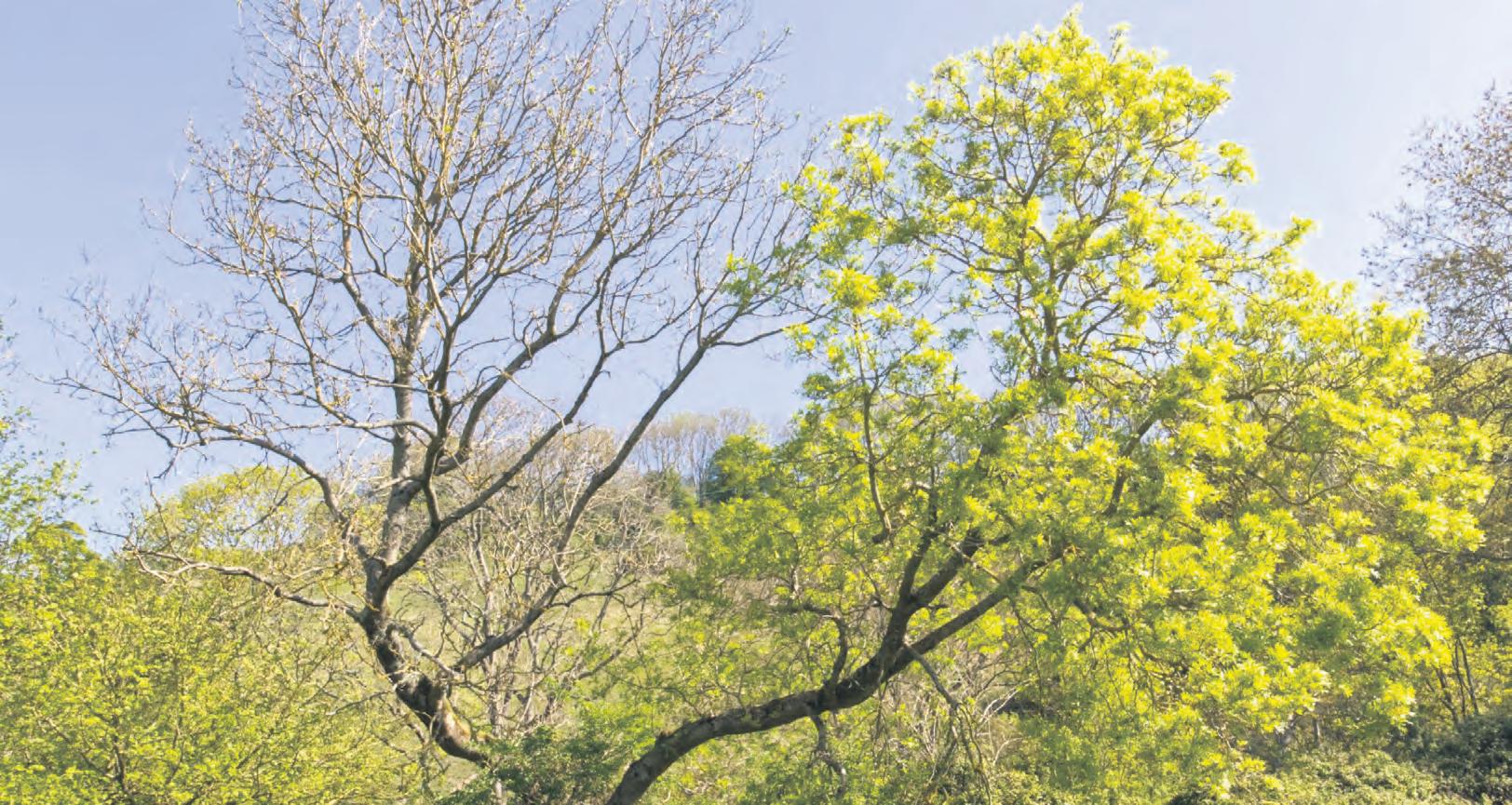
Mark Hinsley reports that thanks to patience and not over reacting there may be some better news on it's way
Back in 2012 Country Gardener Magazine published our answer to a question regarding ash dieback disease in which I cautioned against knee jerk felling of diseased trees and counselled a ‘wait and see’ approach to ash tree management.
Since then, I have warned against the head shaking, teeth sucking brigade of purveyors of fear, conning people with fake news regarding the impact of ash dieback on the structural integrity of the tree. And I named and shamed a council Highway Department who were sending threatening letters to landowners pushing them to fell all their roadside ash trees immediately.
With our own clients I have declined to produce reports condemning diseased ash trees unless they had reached the threshold of 60 per-cent dead. Of course, I have not been alone in issuing such guidance.
Today there was news through membership of the Royal Forestry Society that should gladden the hearts of all who resisted pressure to fell ash trees early.
Scientists at RBG Kew and Queen Mary University of London have found evidence that young ash tree populations are evolving resistance to ash dieback.
This is the great difference between the last major tree disease – Dutch Elm Disease –and the current one – ash dieback. Elms did not set viable seed so all where propagated vegetatively, through cuttings in the nursery and via suckers in the wild. This meant that all elms were genetically identical, and one disease kills all.
Ash on the other hand reproduce sexually. Ash trees can be both monoecious – male and female flowers on the same tree – or diecious – male and female flowers on separate trees. However, even when male and female flowers are on the same tree they cannot selfpollinate.
Ash trees are wind pollinated; they do not rely on insects to vector their pollen between trees. This means that their seed has the genetic material of two different parents, which creates genetic diversity within the population.
Keeping trees which, though infected, are not immediately killed by ash dieback, has
01823 431767
01278 786139
allowed these survivor trees to cross pollinate each other. Now, through a process known as polygenic evolution, young trees with enhanced resistance to ash dieback have been found to be emerging.

To quote Winston Churchill – ‘This is not the end, it is not even the beginning of the end, but it may be the end of the beginning’.
Resistance is not immunity, but it is going in the right direction. The build-up of natural immunity can be a slow process. It takes an ash tree 10 years before it can produce flowers. Retaining ash trees across the landscape has been vital because, if the gaps between live trees is too great, the pollen produced by one does not reach another.
Scientists are looking to employ techniques used in the cut flower/horticulture industry to accelerate the flowering process and artificially ensure selected pollination.
But this is a desperate measure to try to ensure survival of the species.
Our landscape relies on millions of ash trees for its character and a significant amount of its wildlife. If that is to survive for the next couple of generations to see, we need the natural process of survival of the fittest to pull the ash through.
So, gentle reader, if you are one of those doughty souls who did not fell your ash at the first sign of disease, don’t give up now. Keep them as long as it is reasonably safe to do so in the hope that seedlings from your trees will beat the dieback and secure the species place in our landscape.
Mark Hinsley, of Mark Hinsley Arboricultural Consultants Ltd, offering tree consultancy services. www.treeadvice.info
Reay - Cotswolds, Devon & Dorset corina@countrygardener.co.uk Tel: 01823 410098



